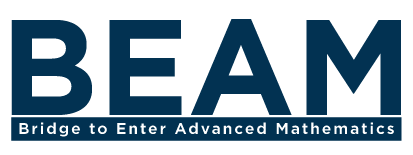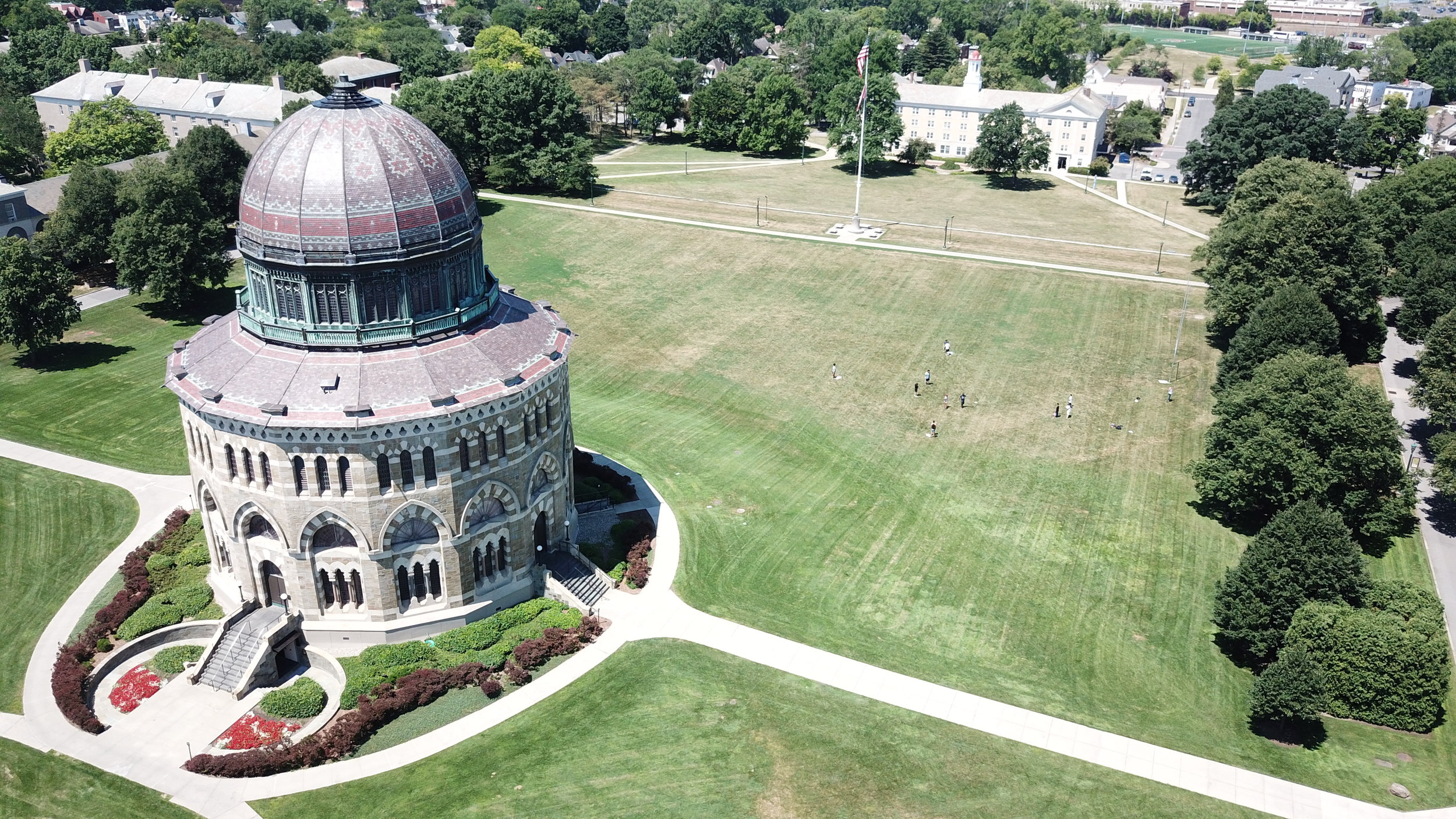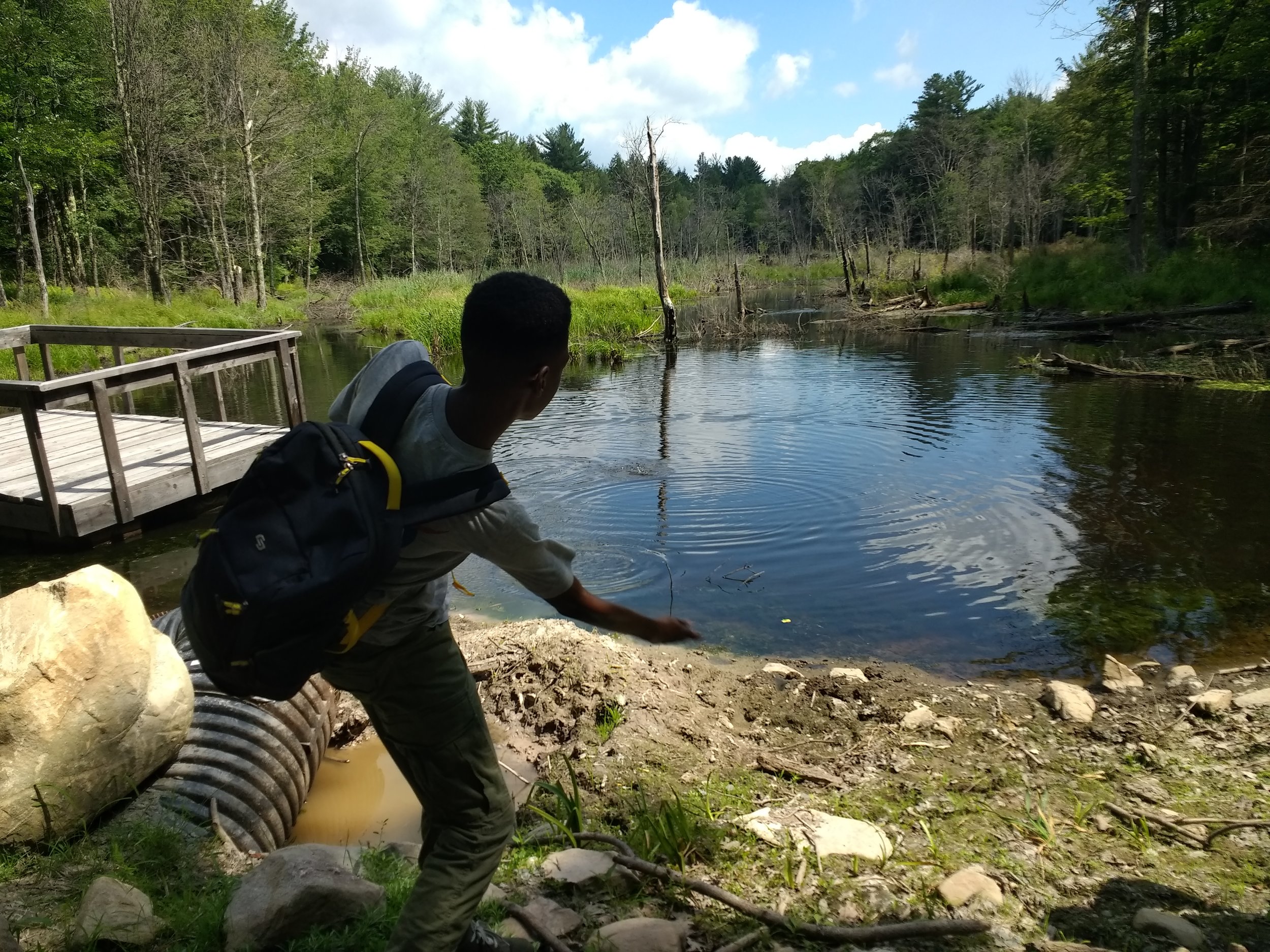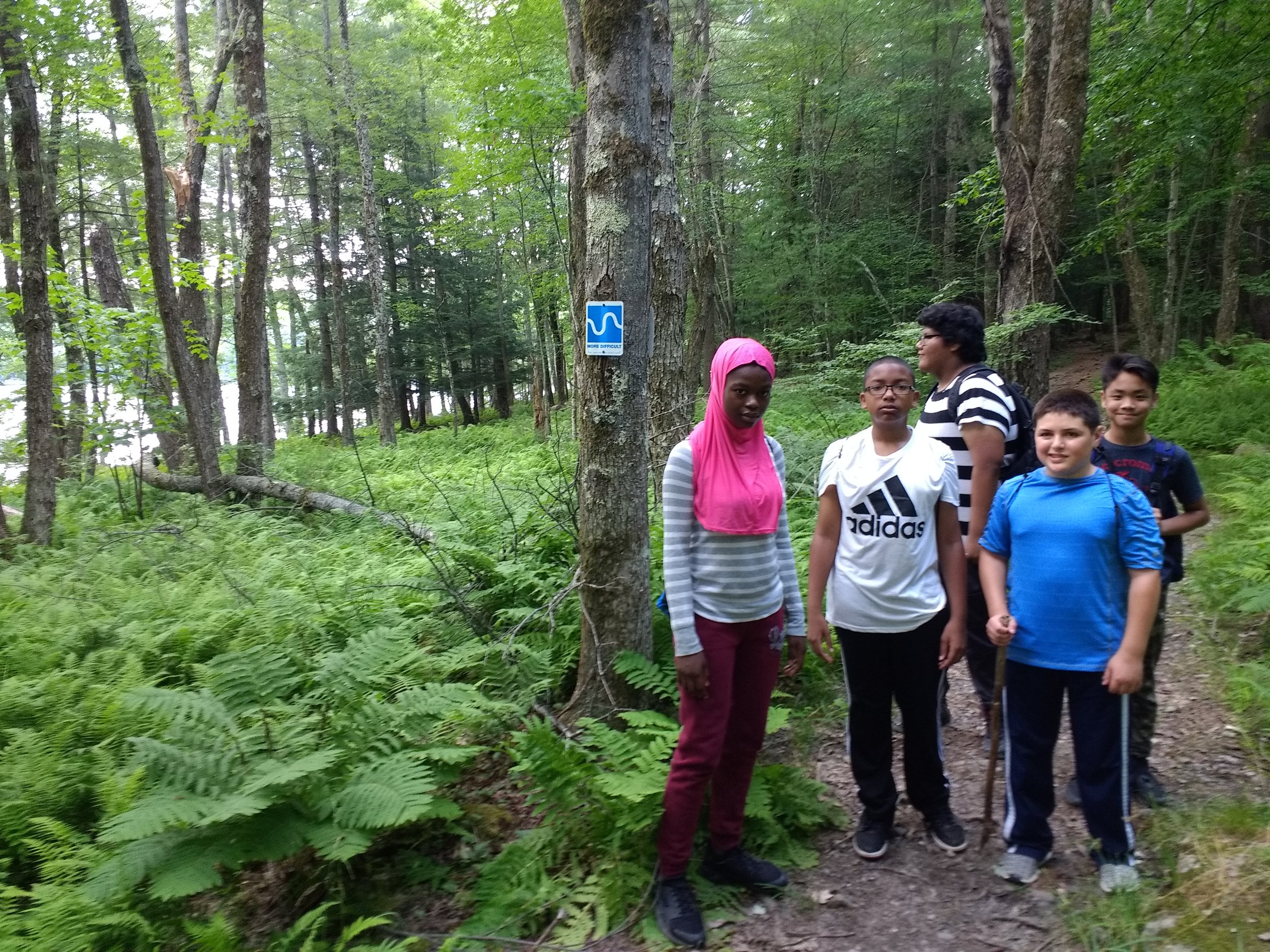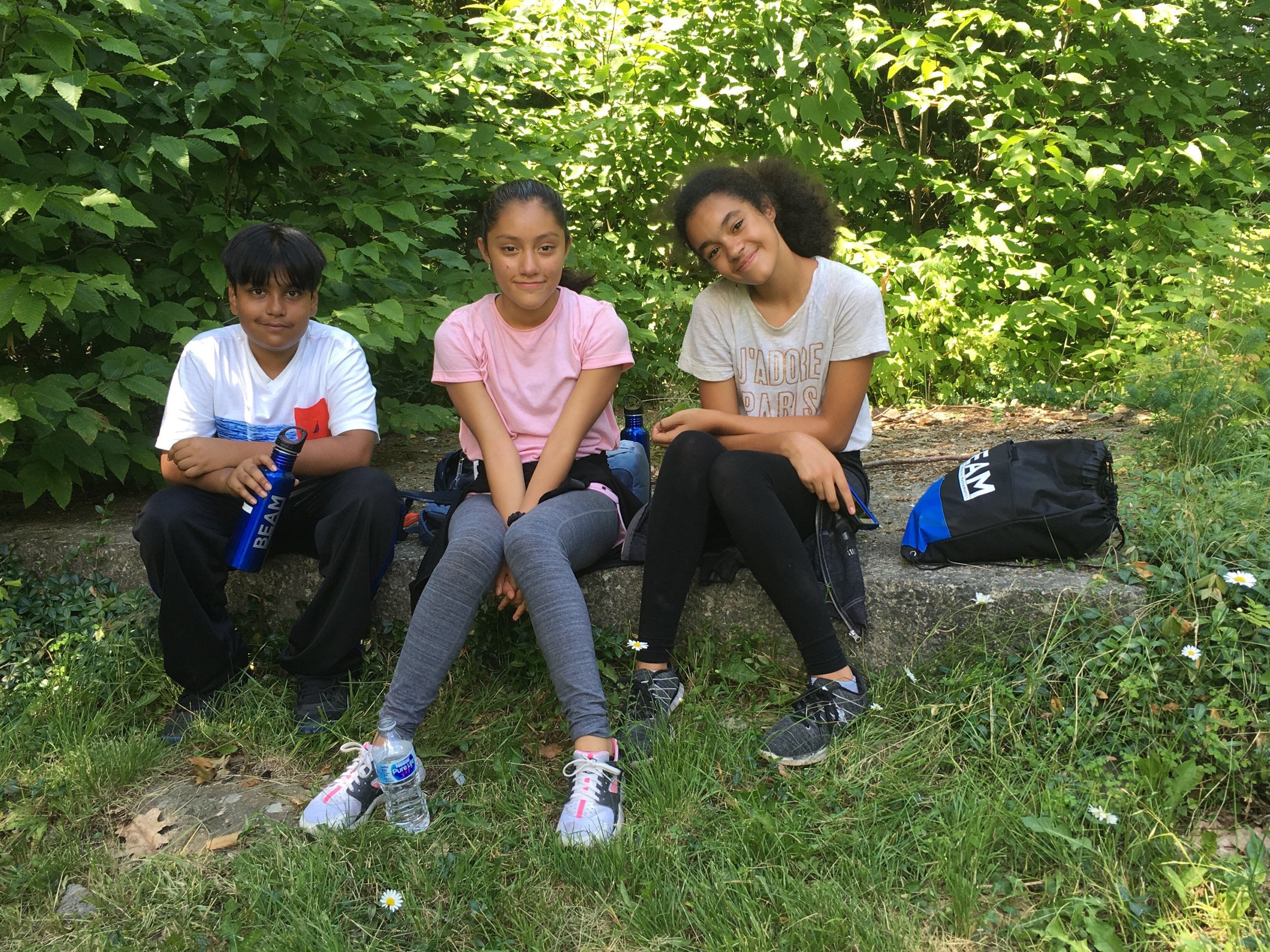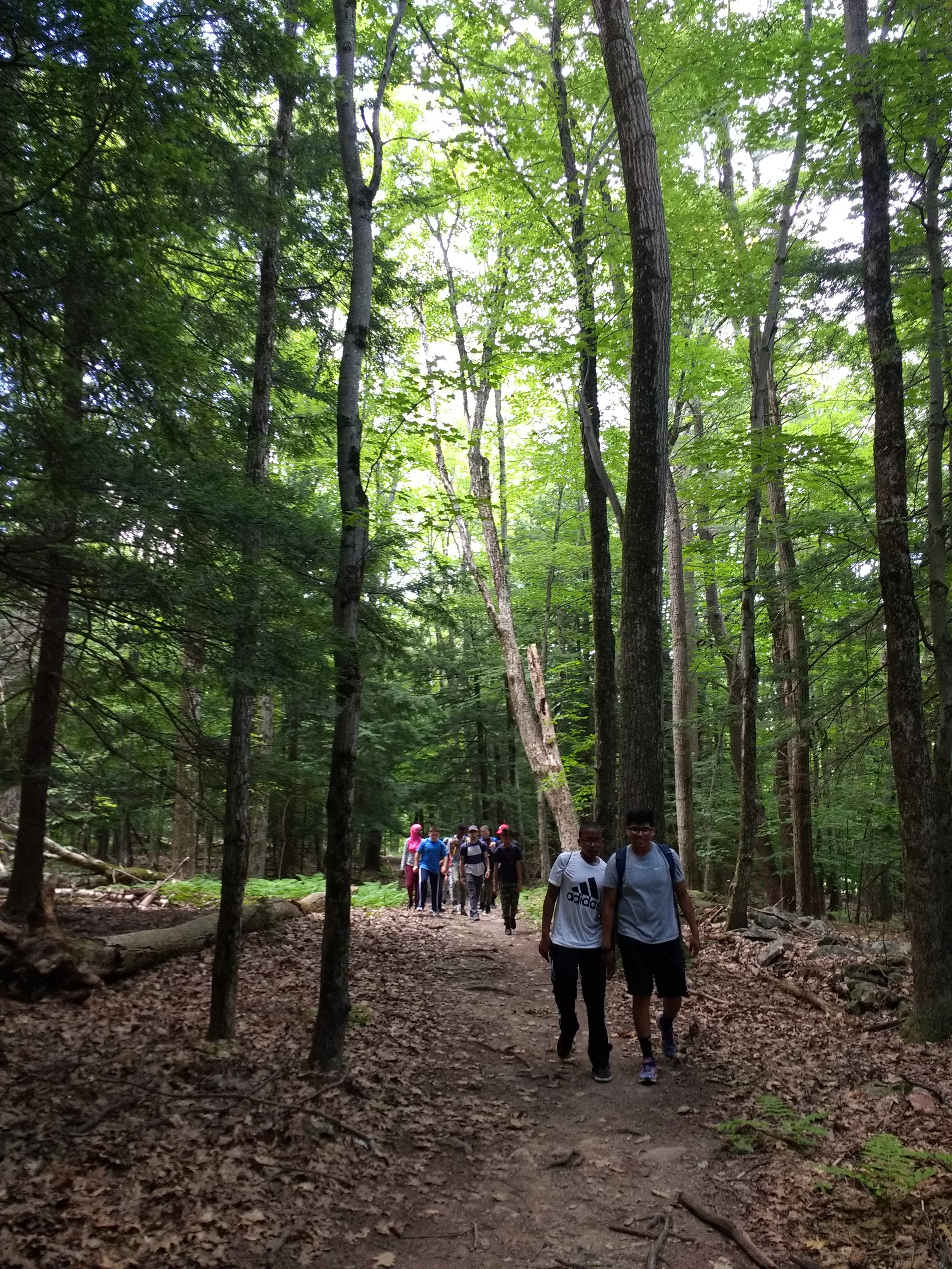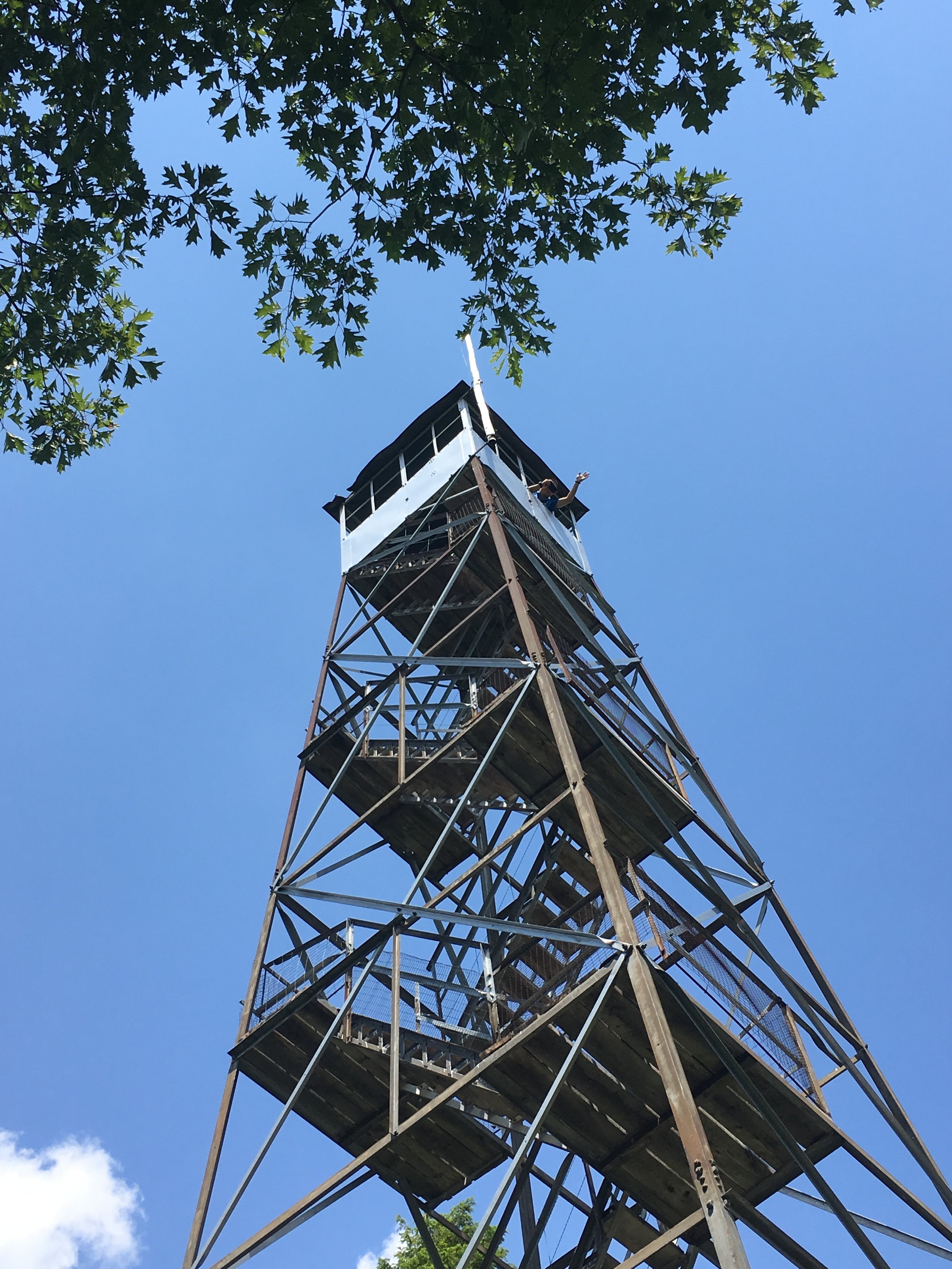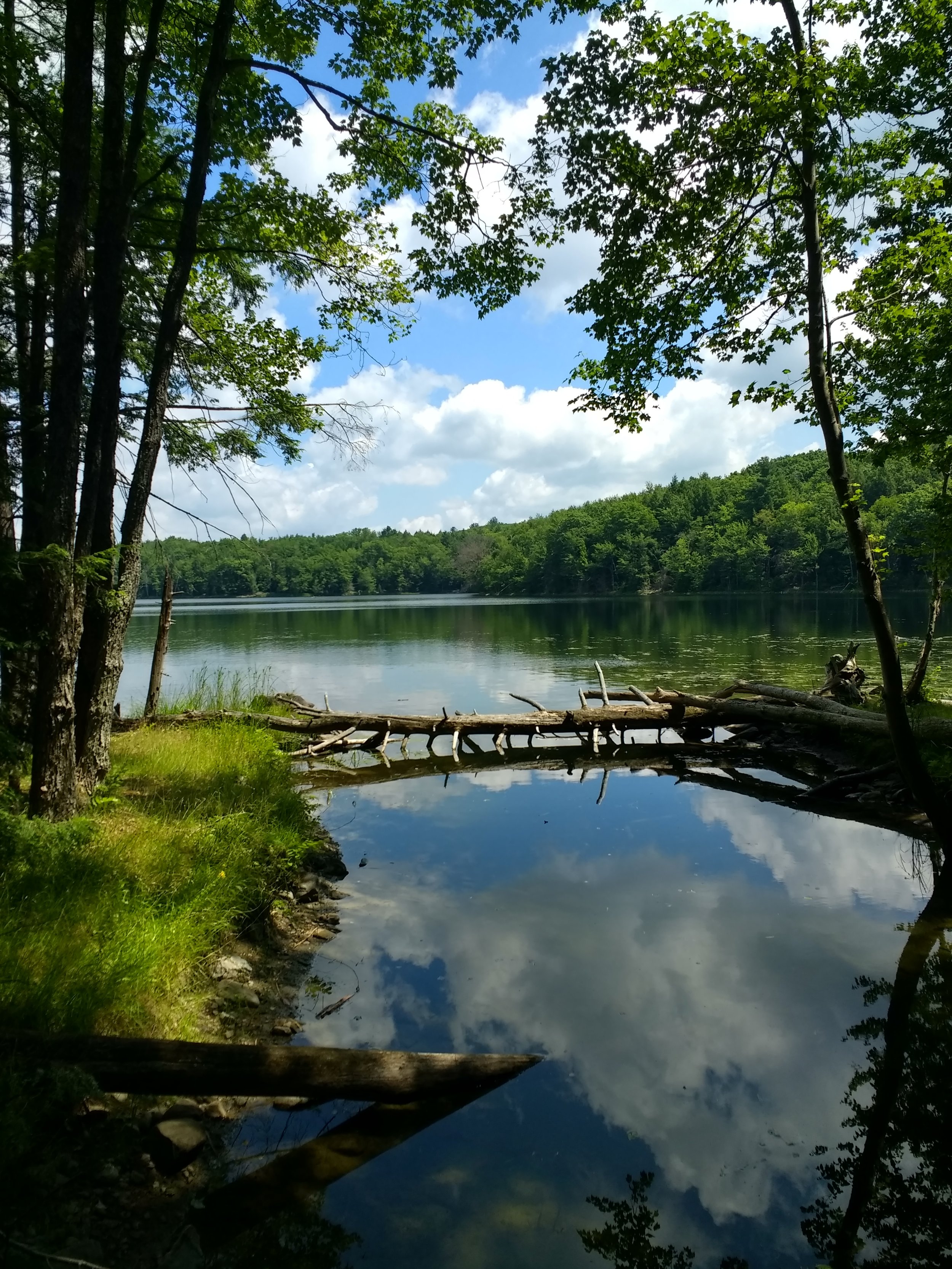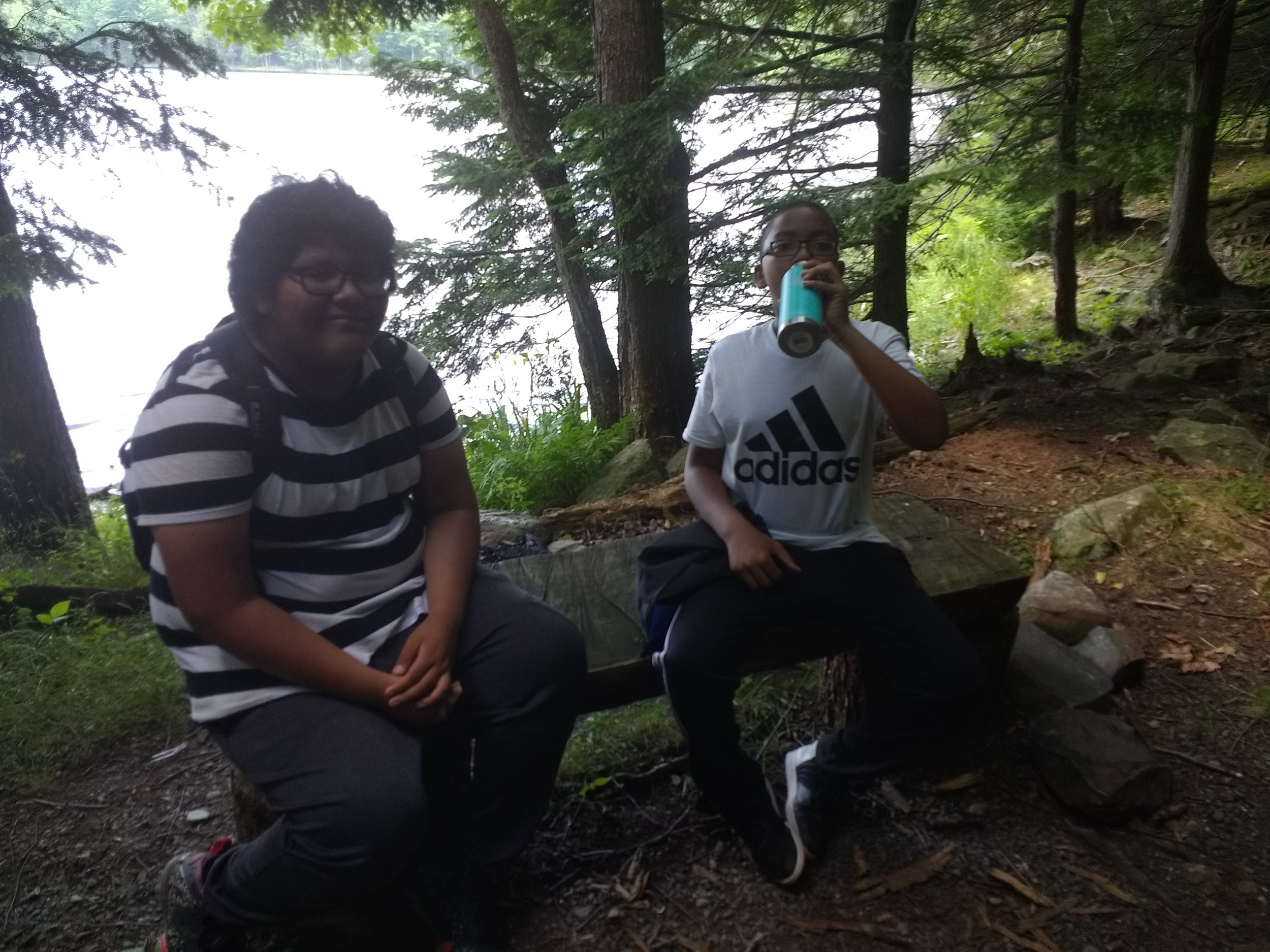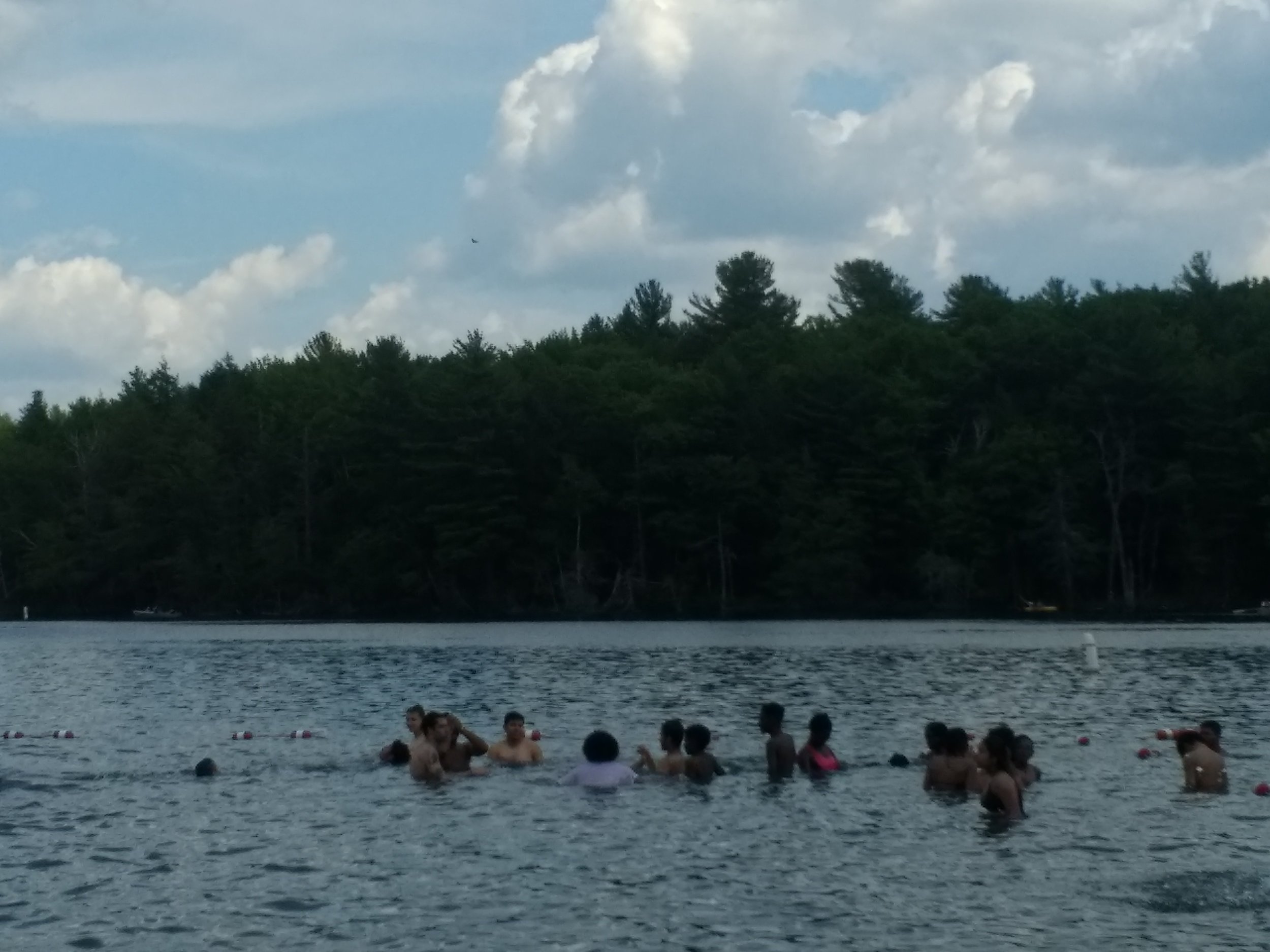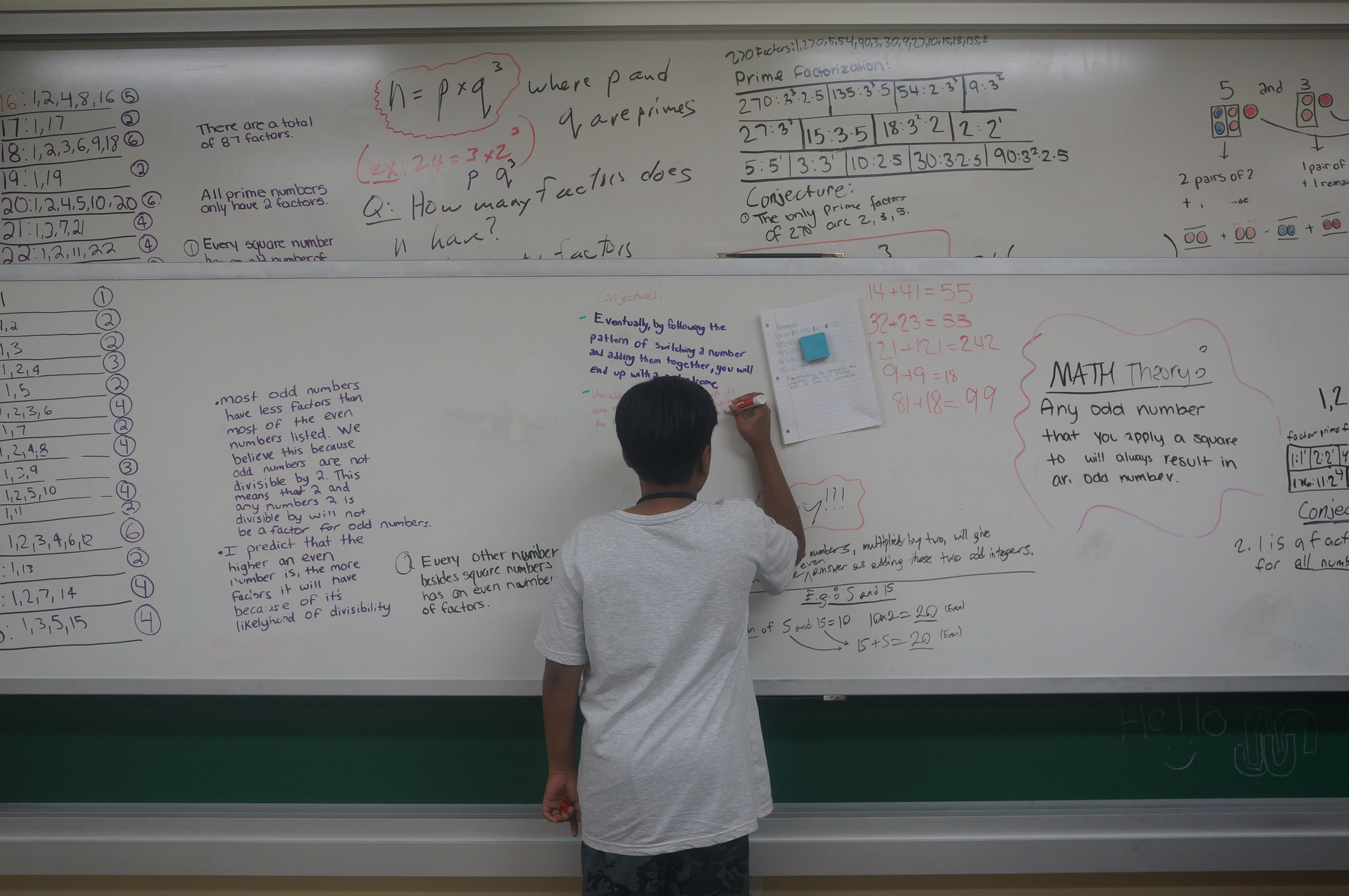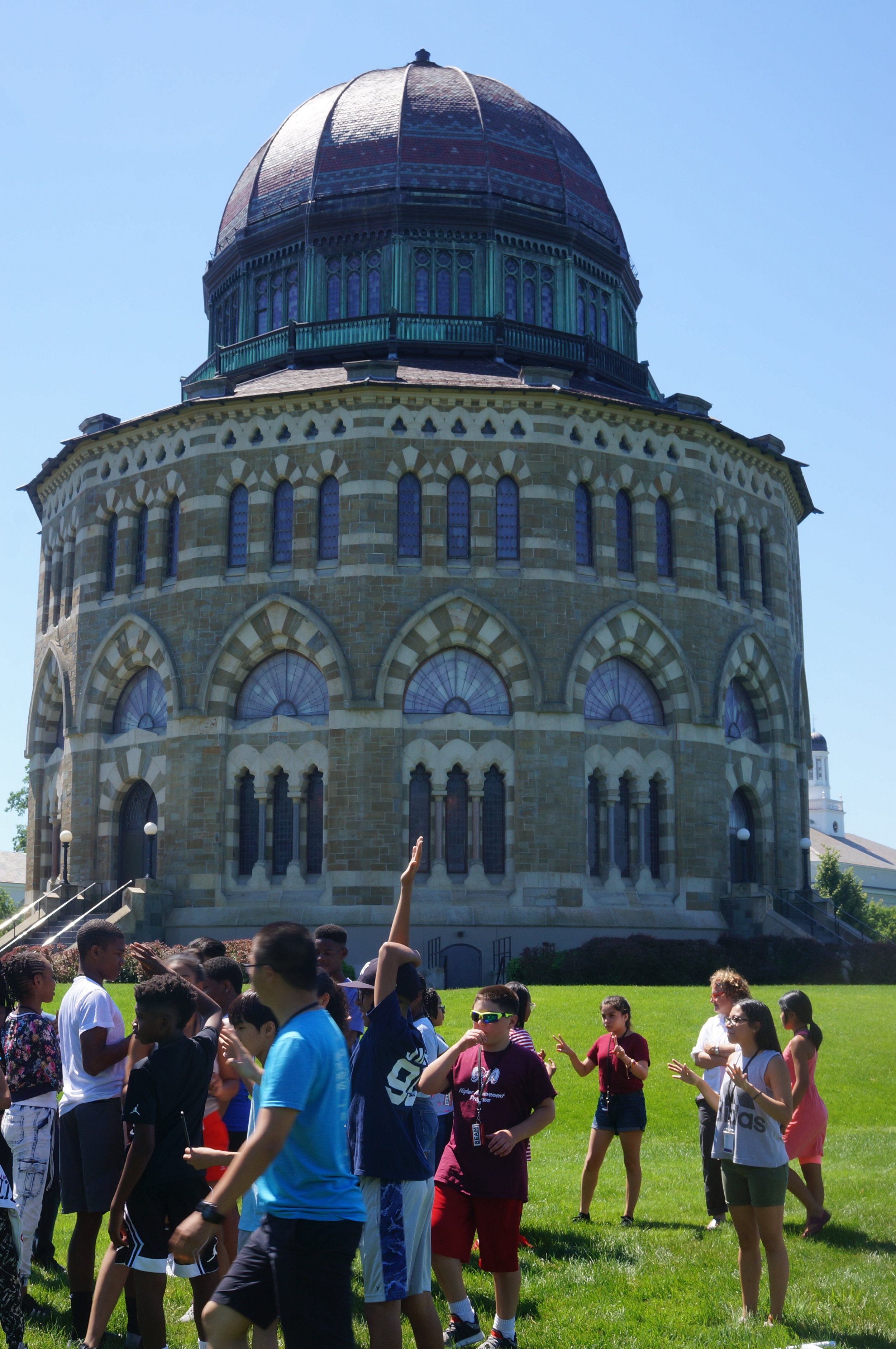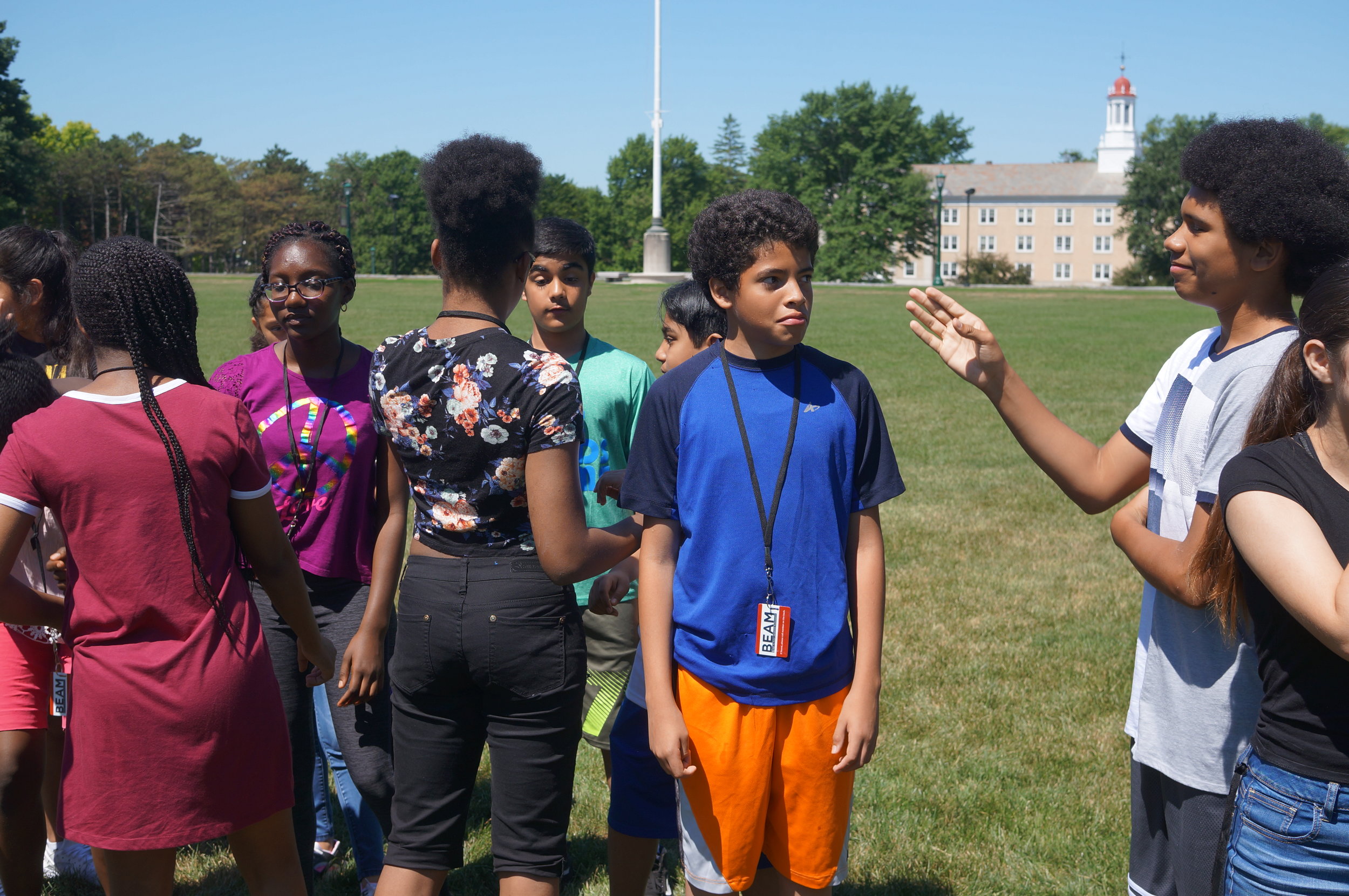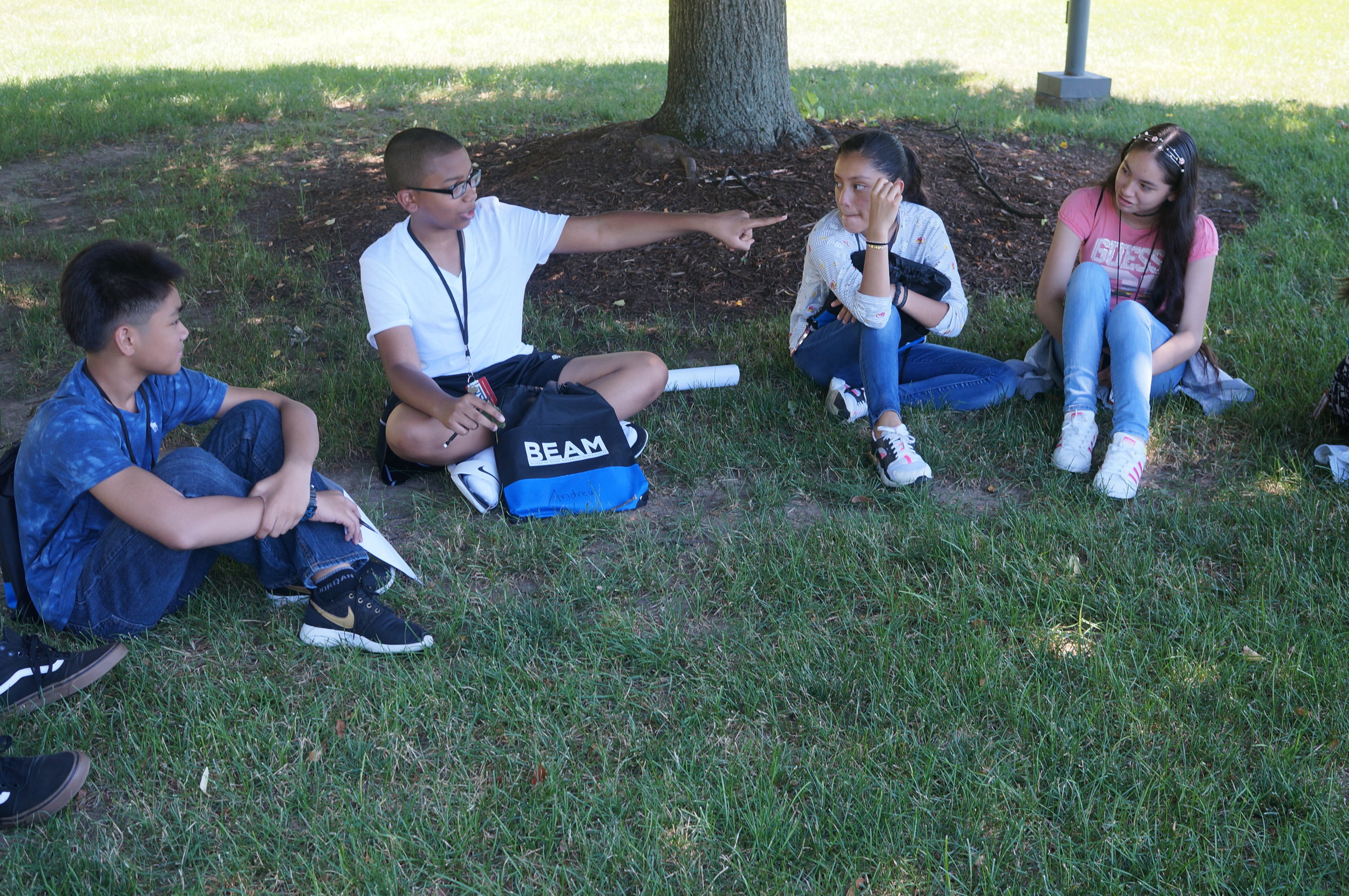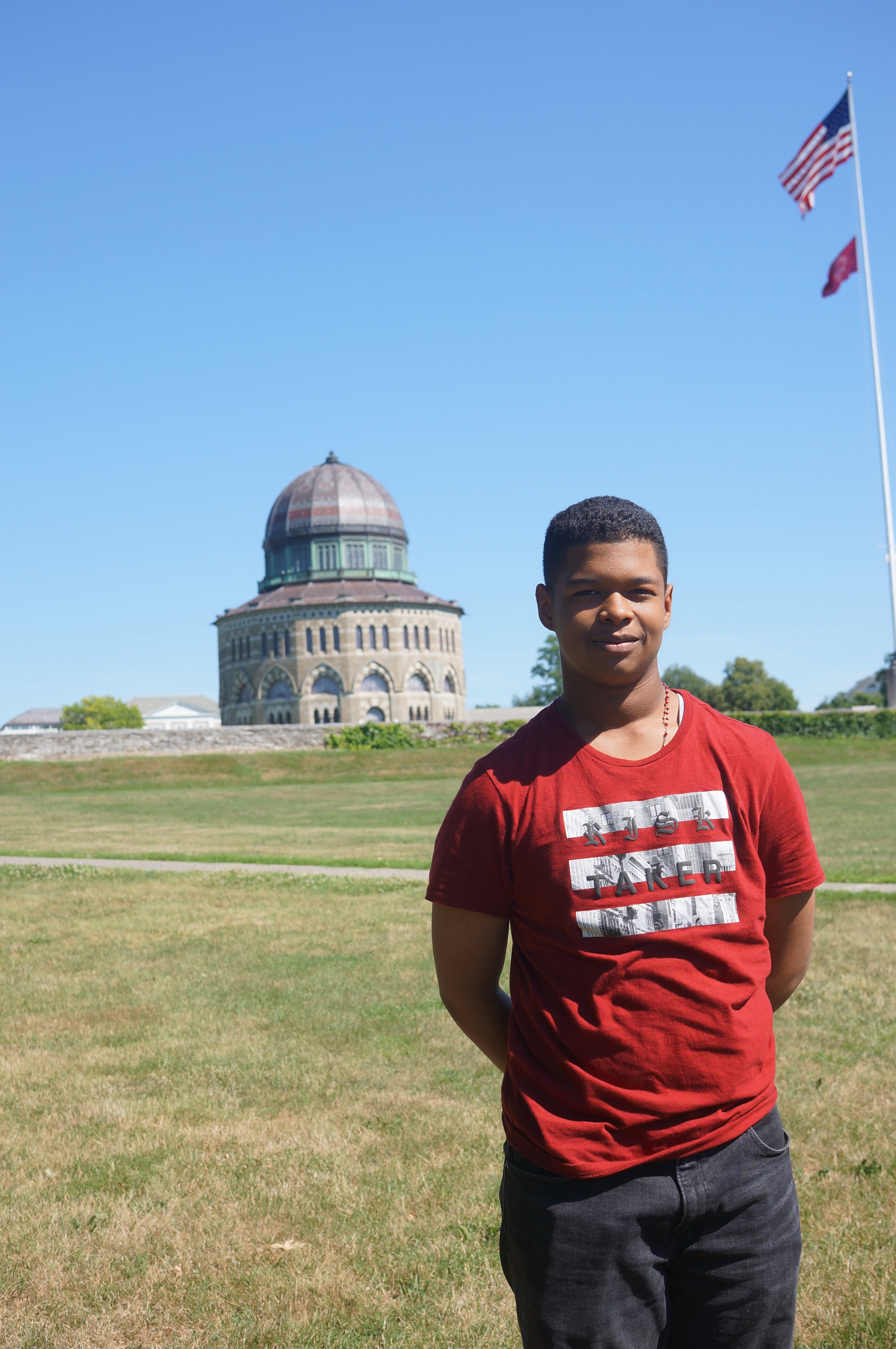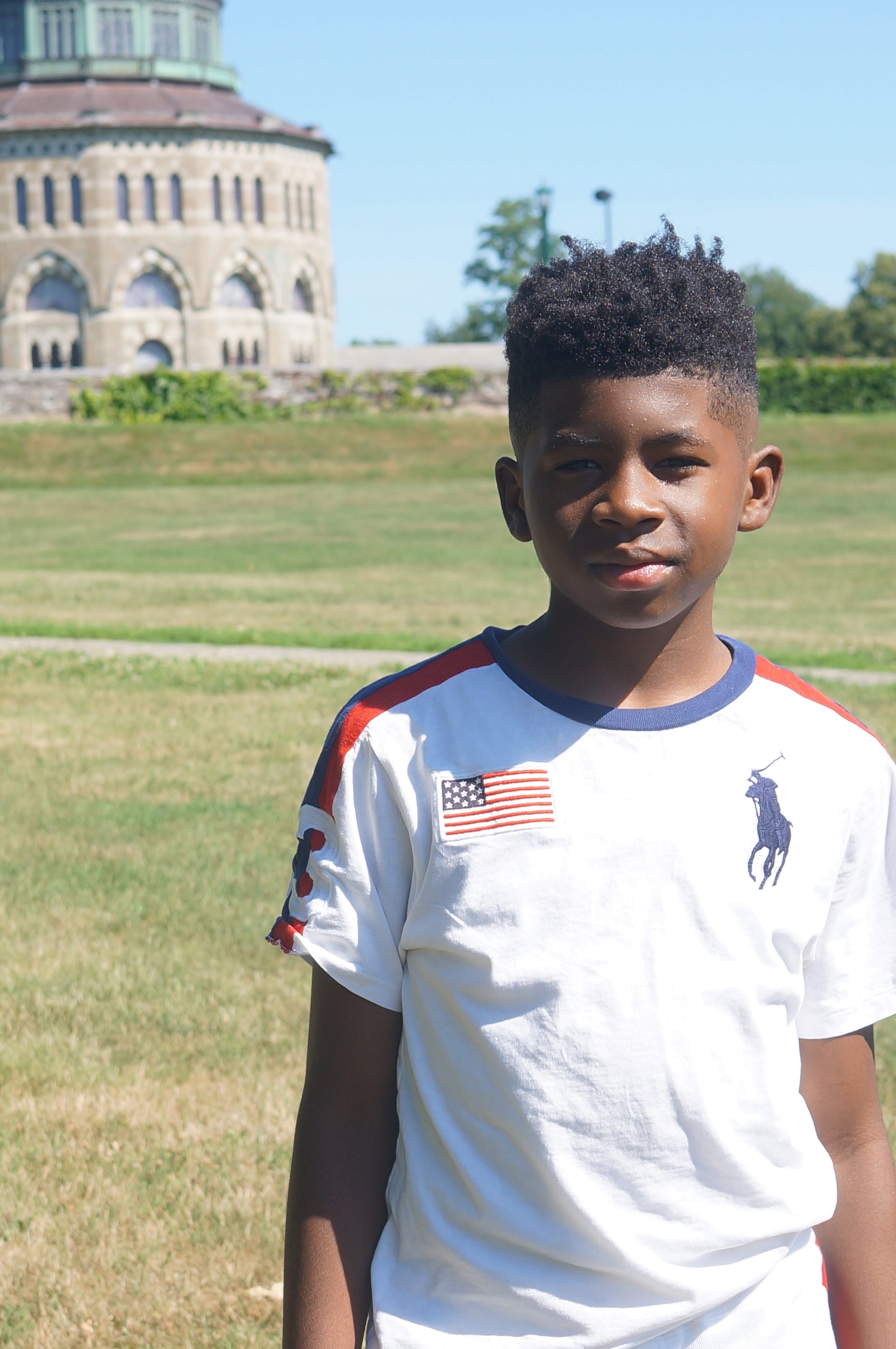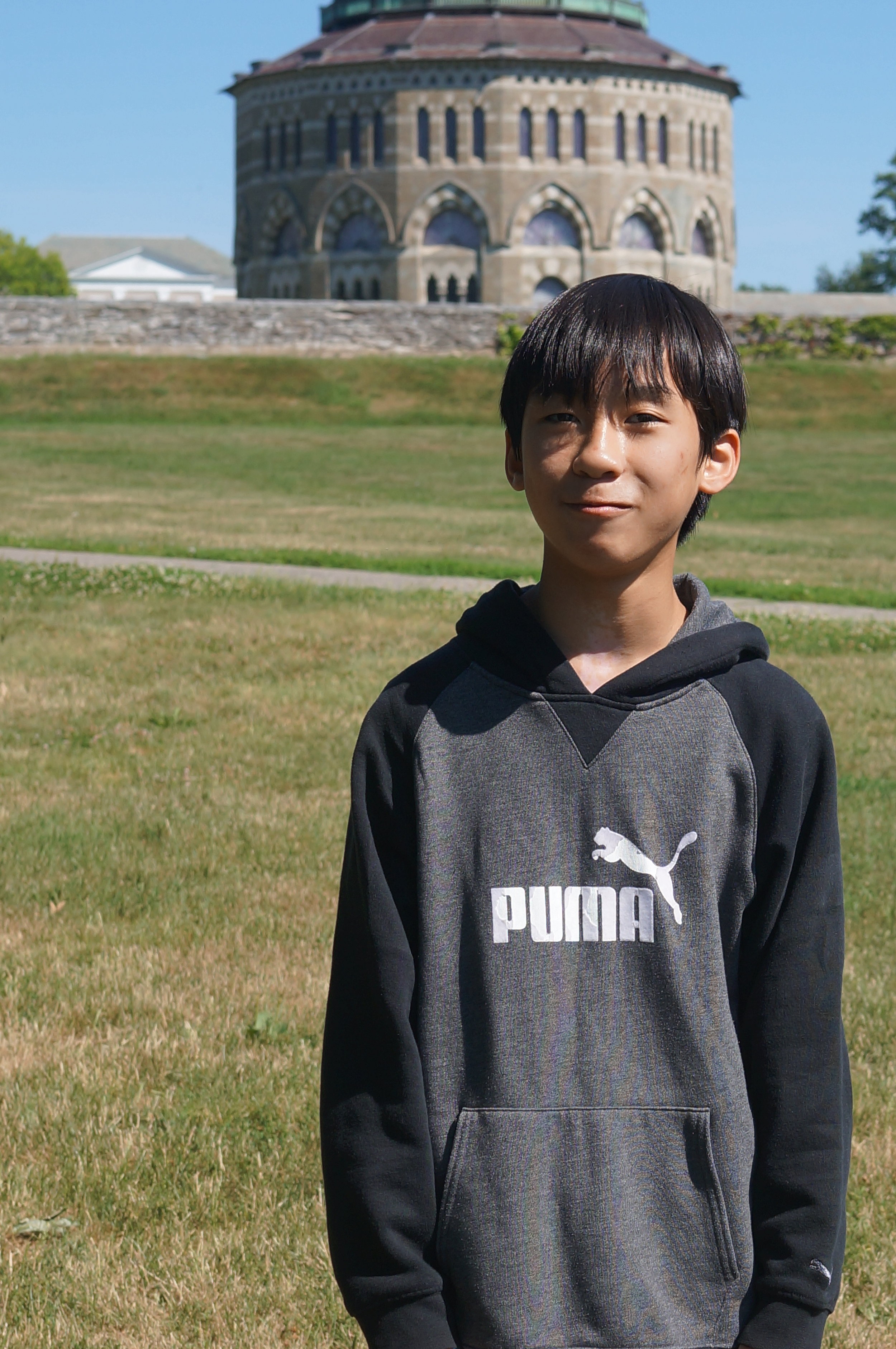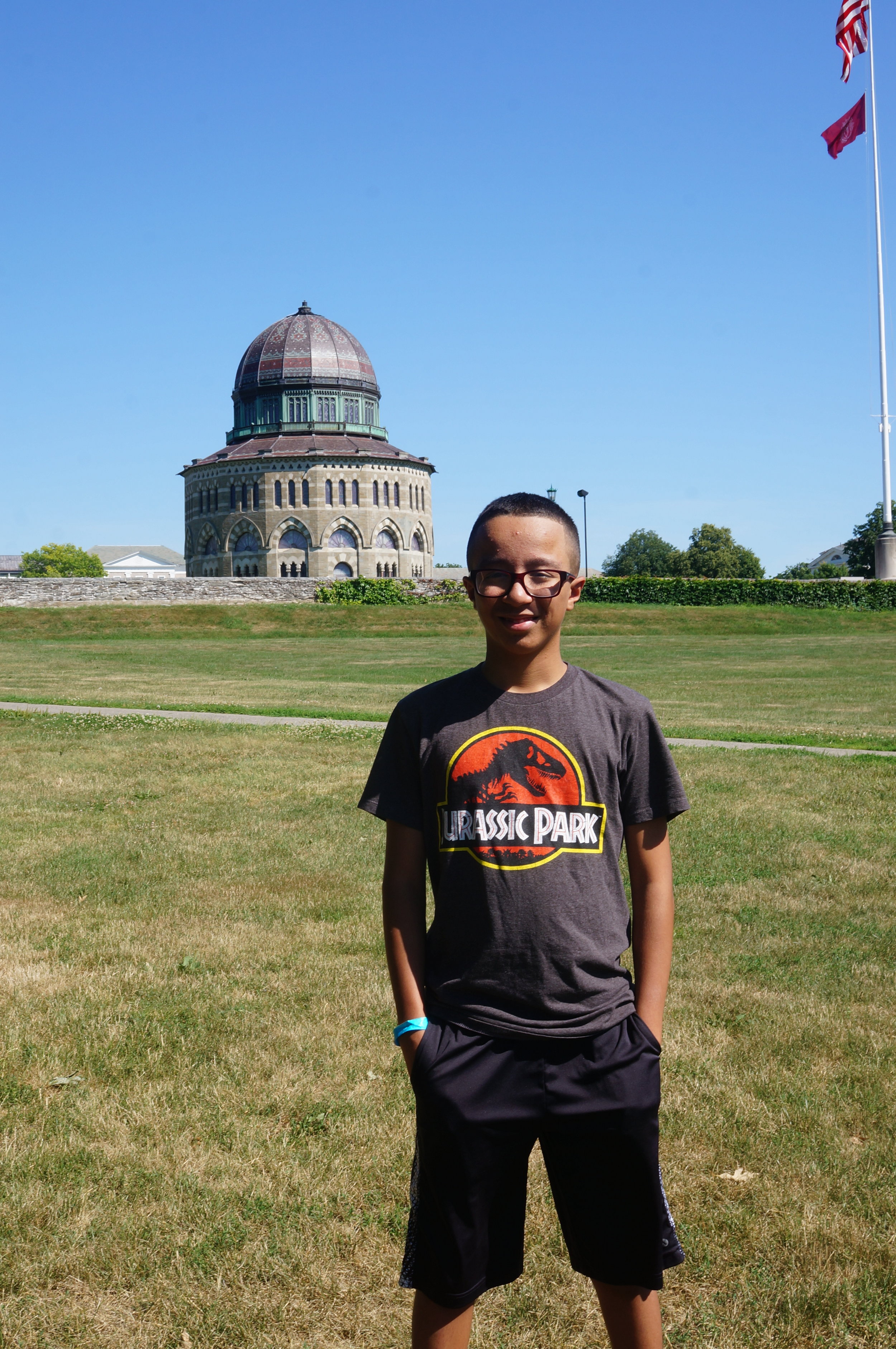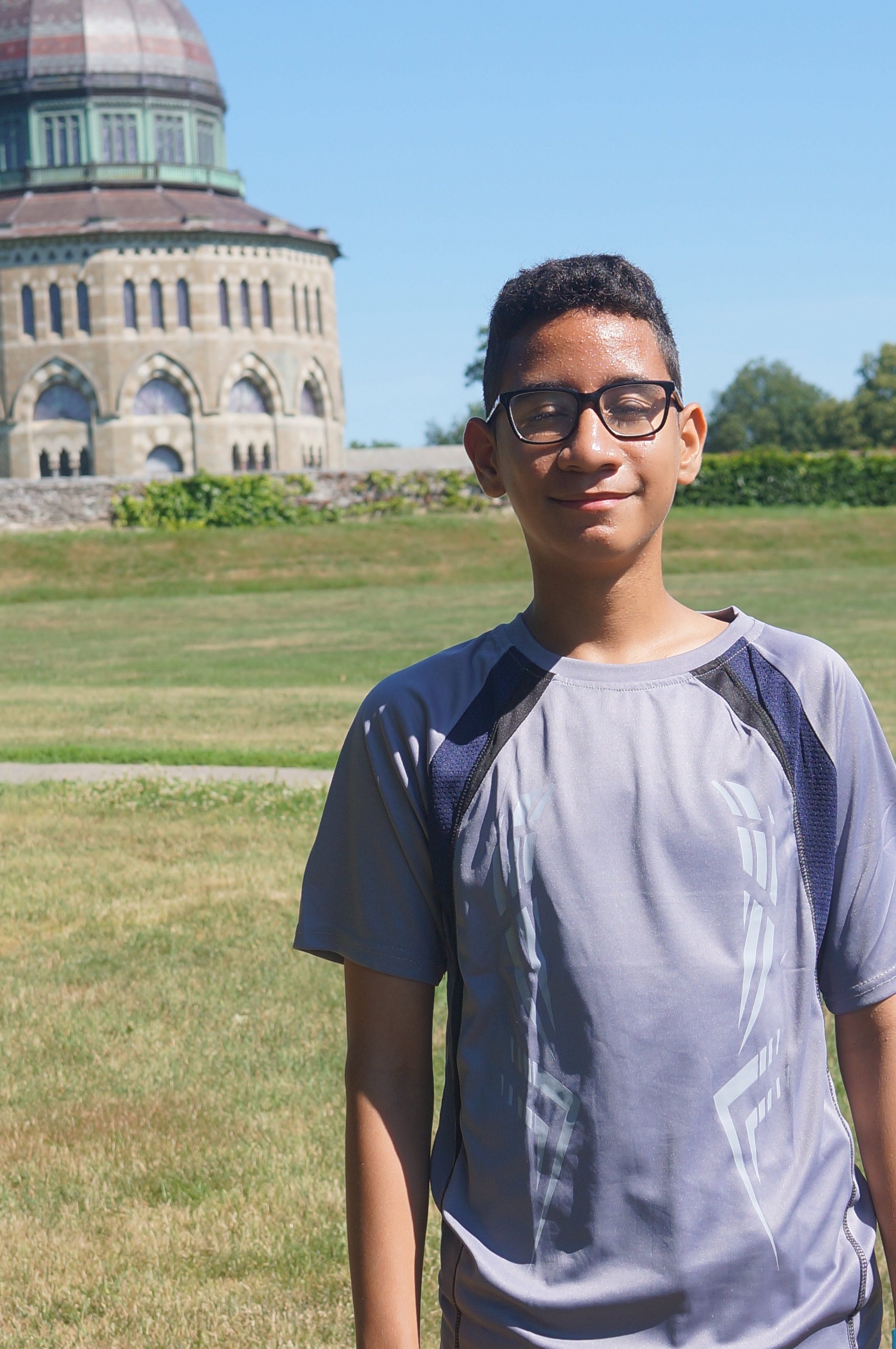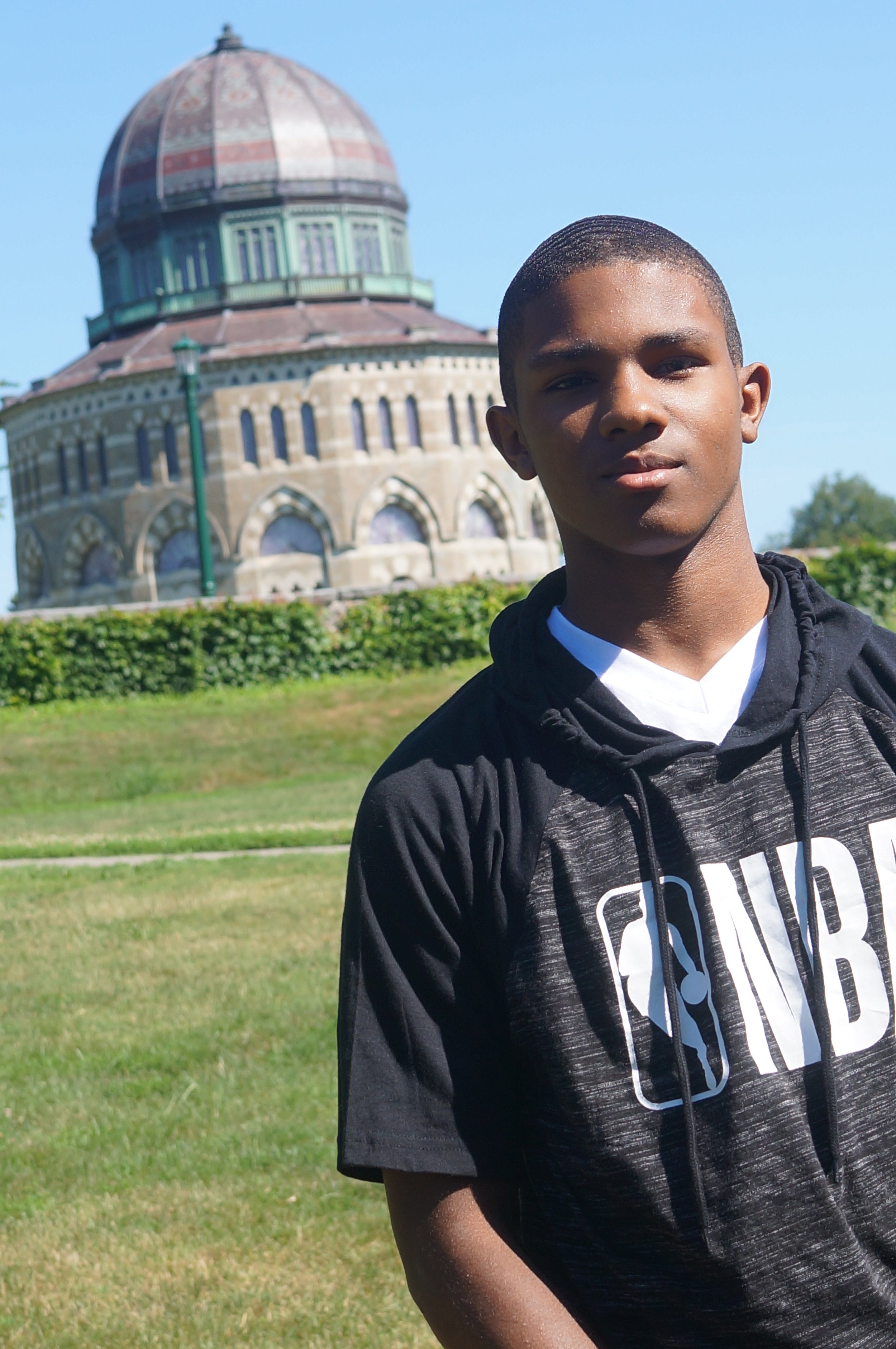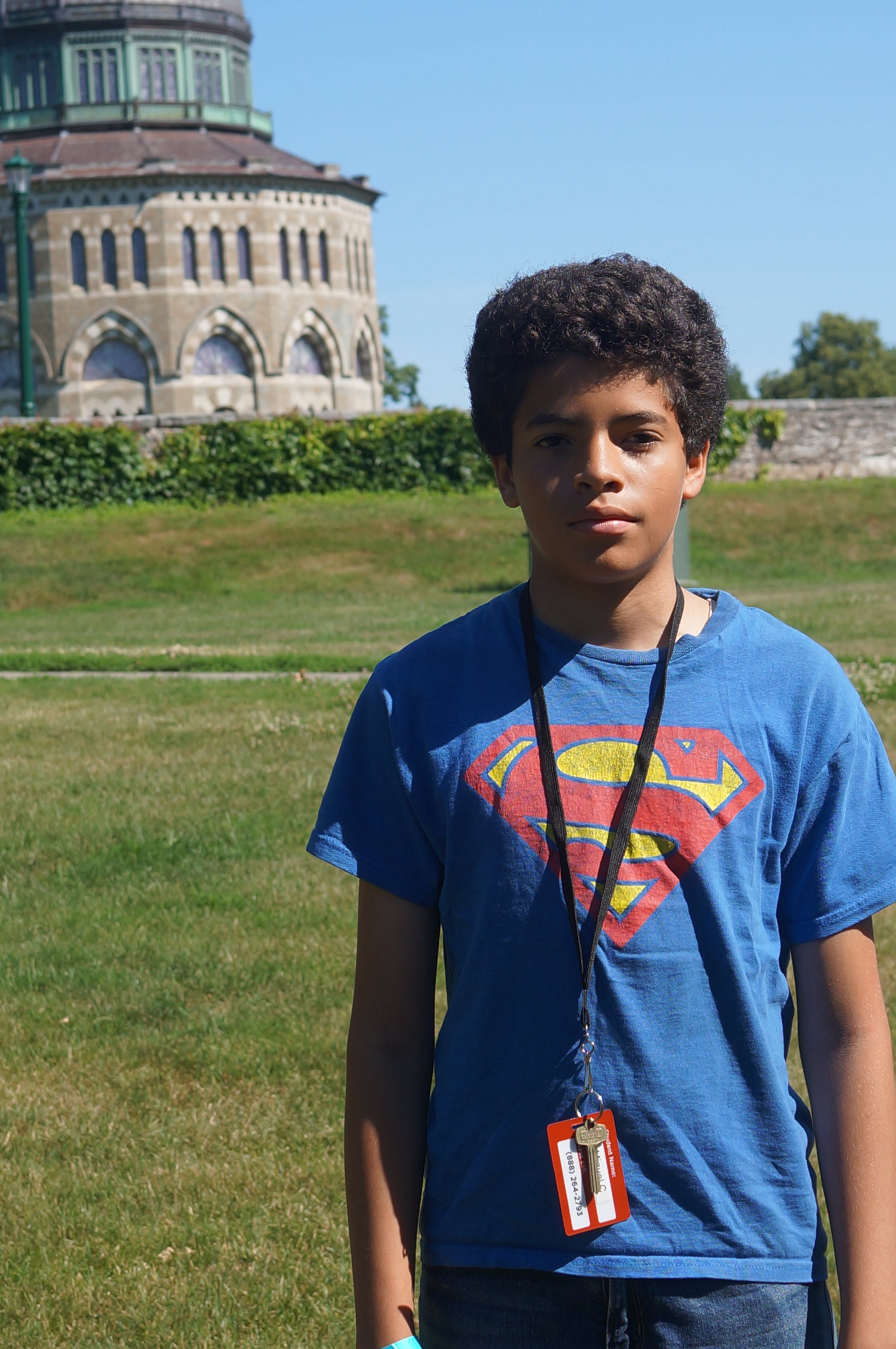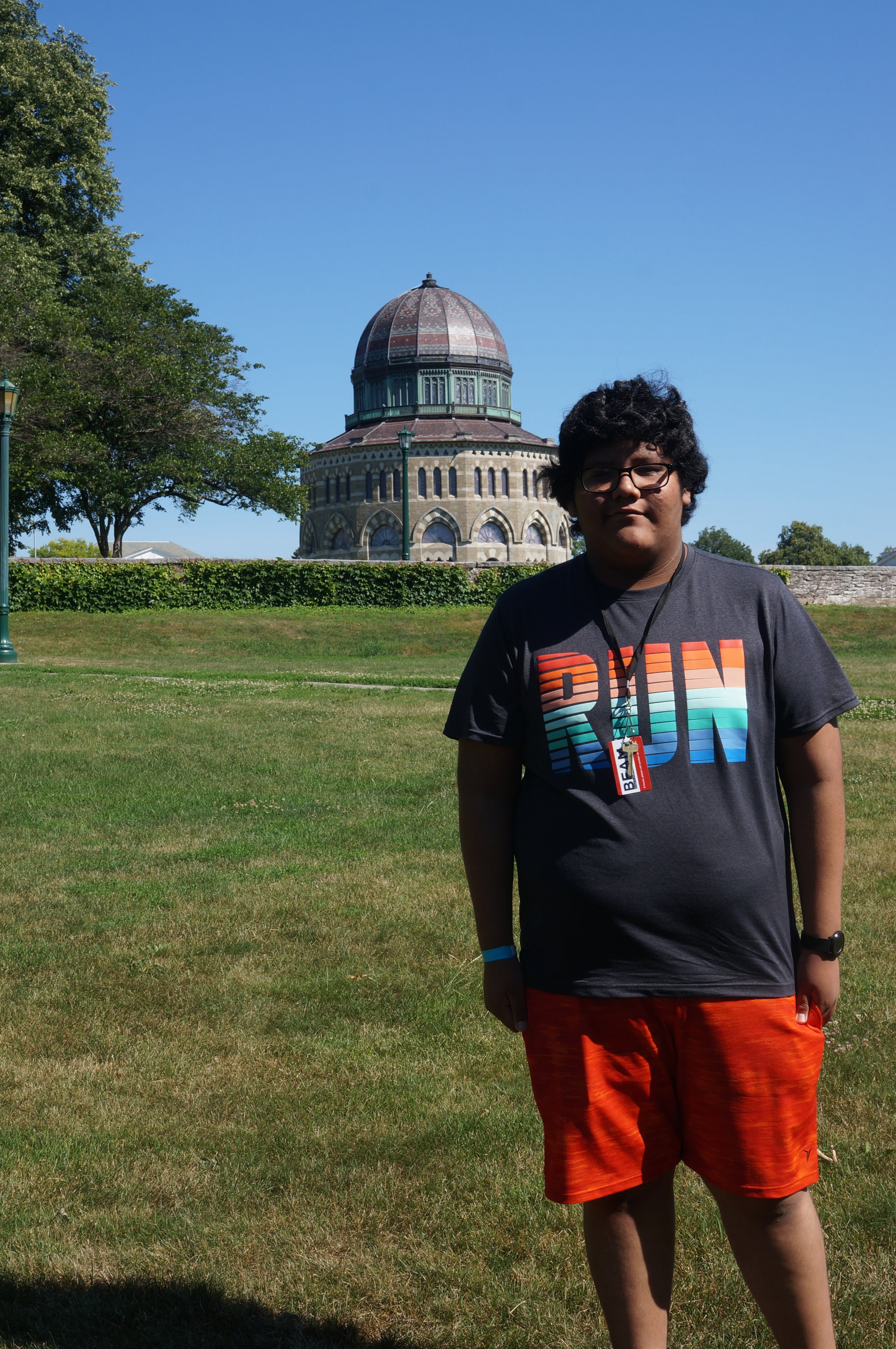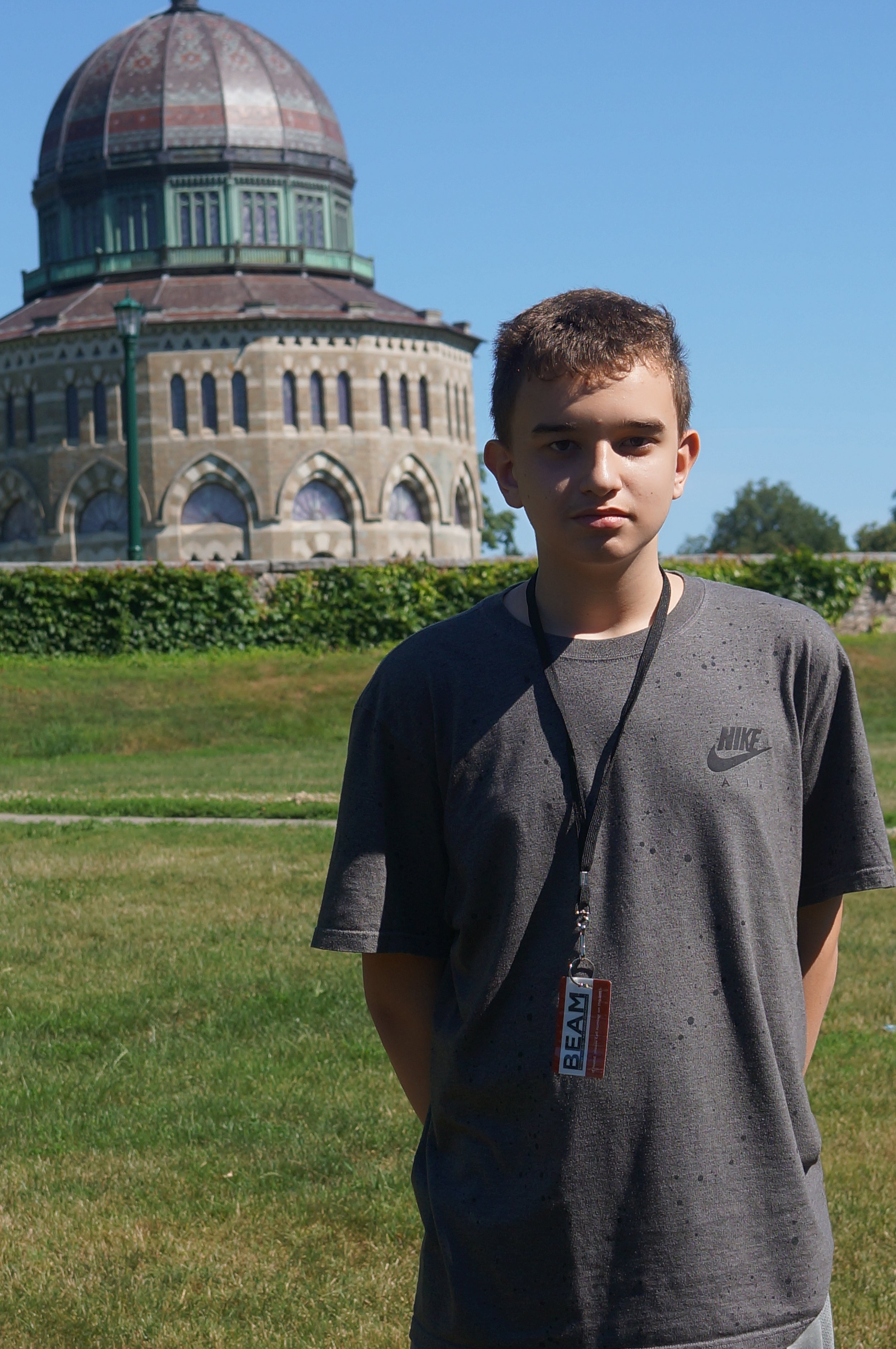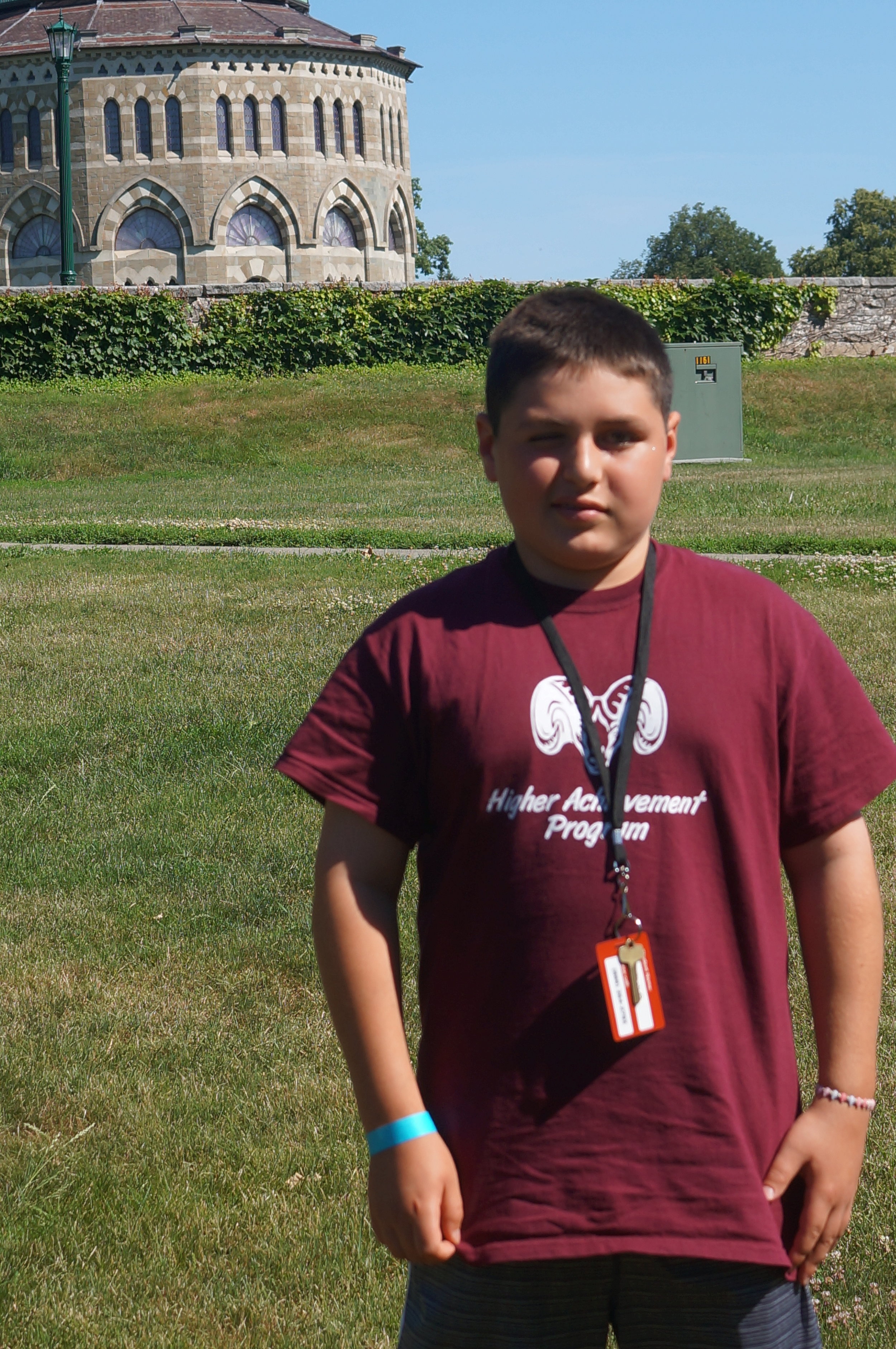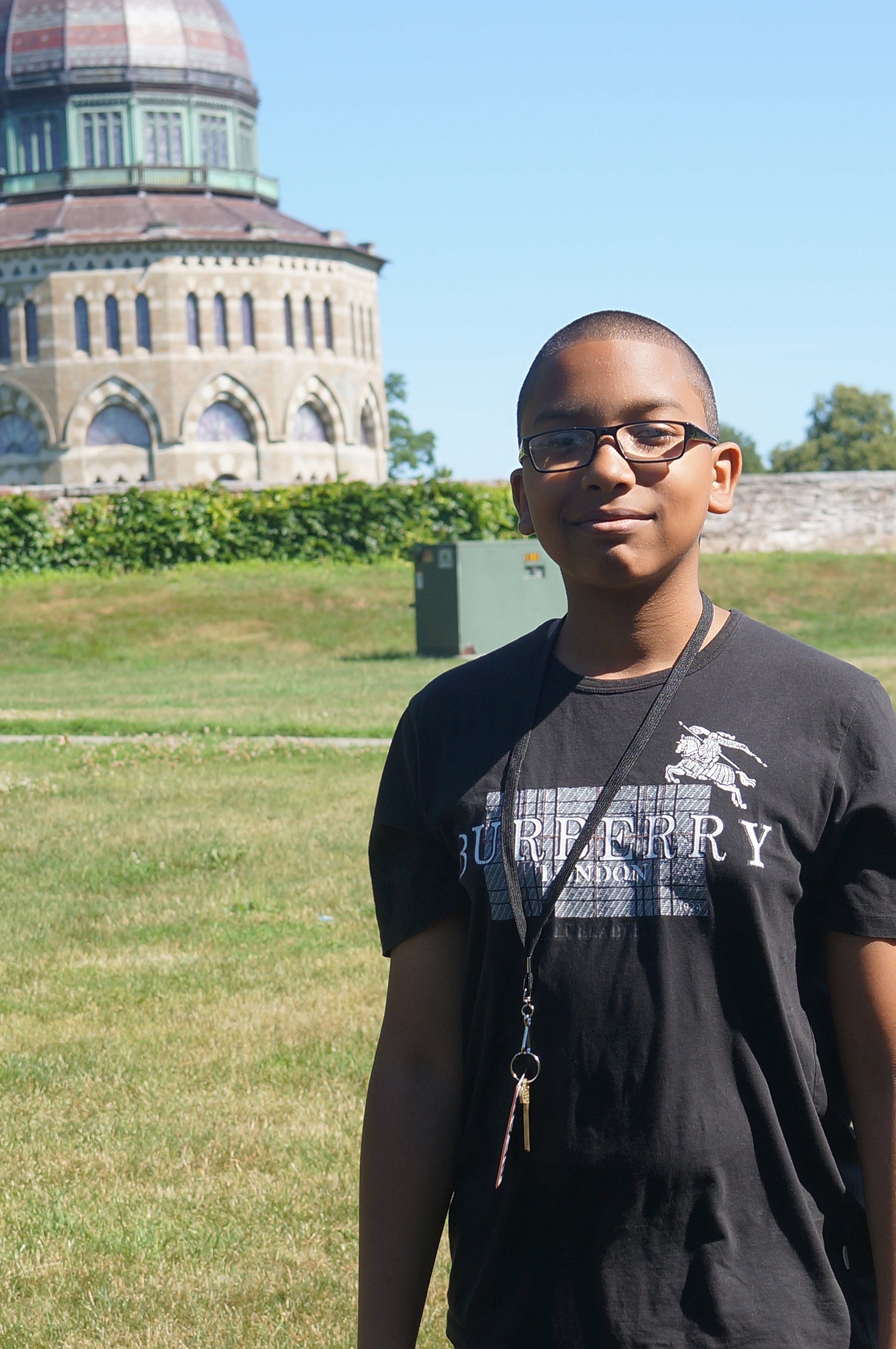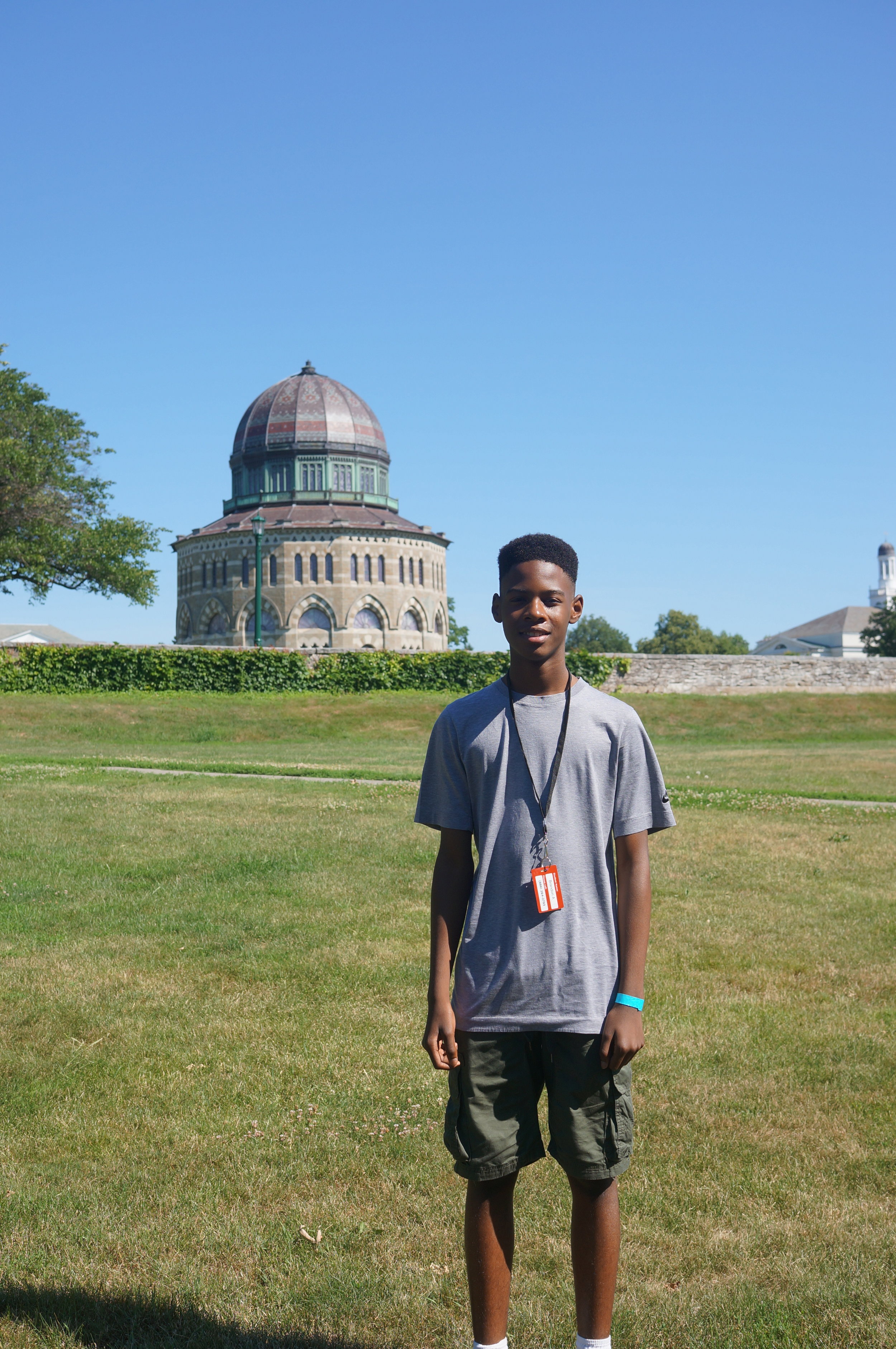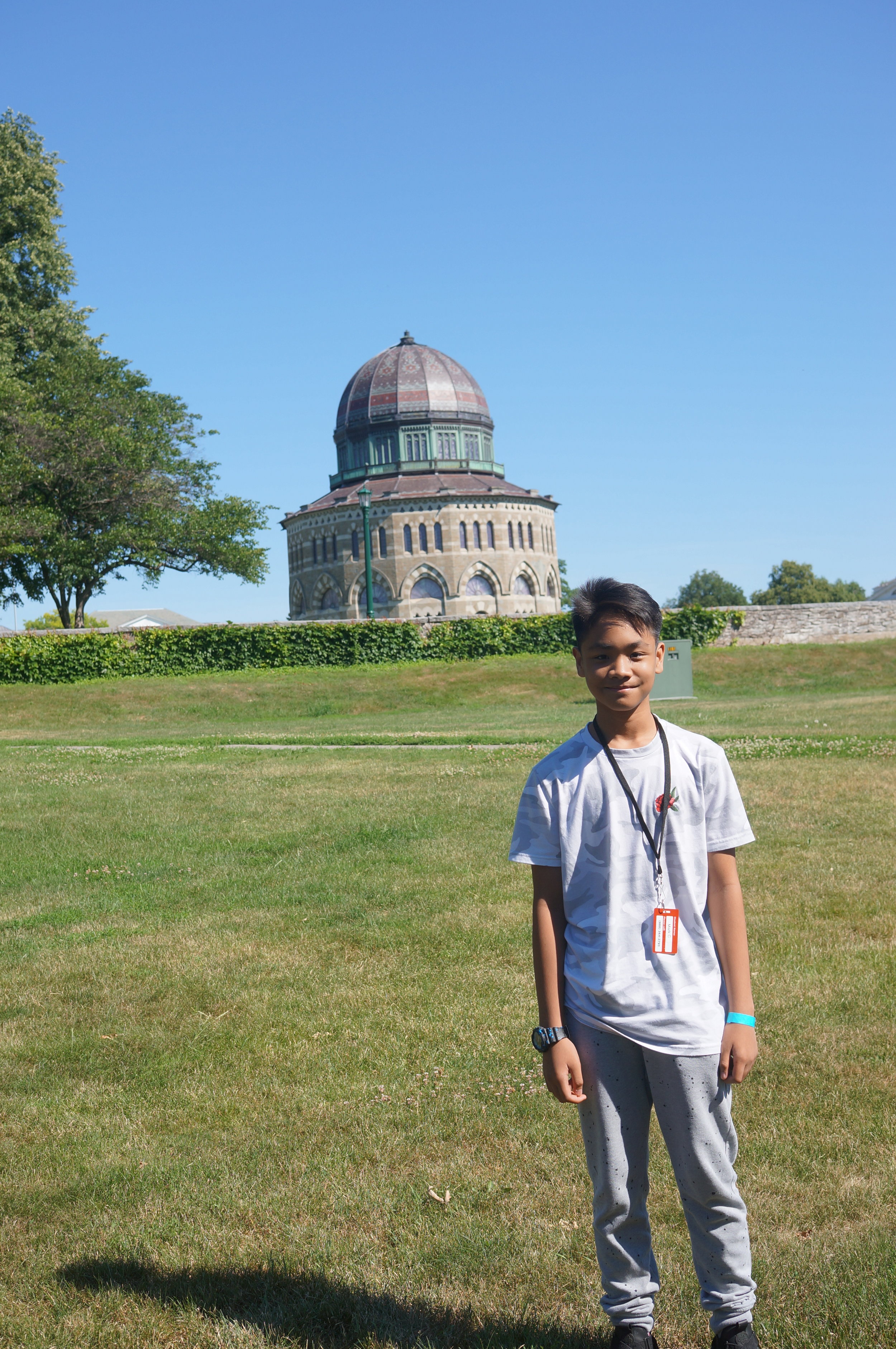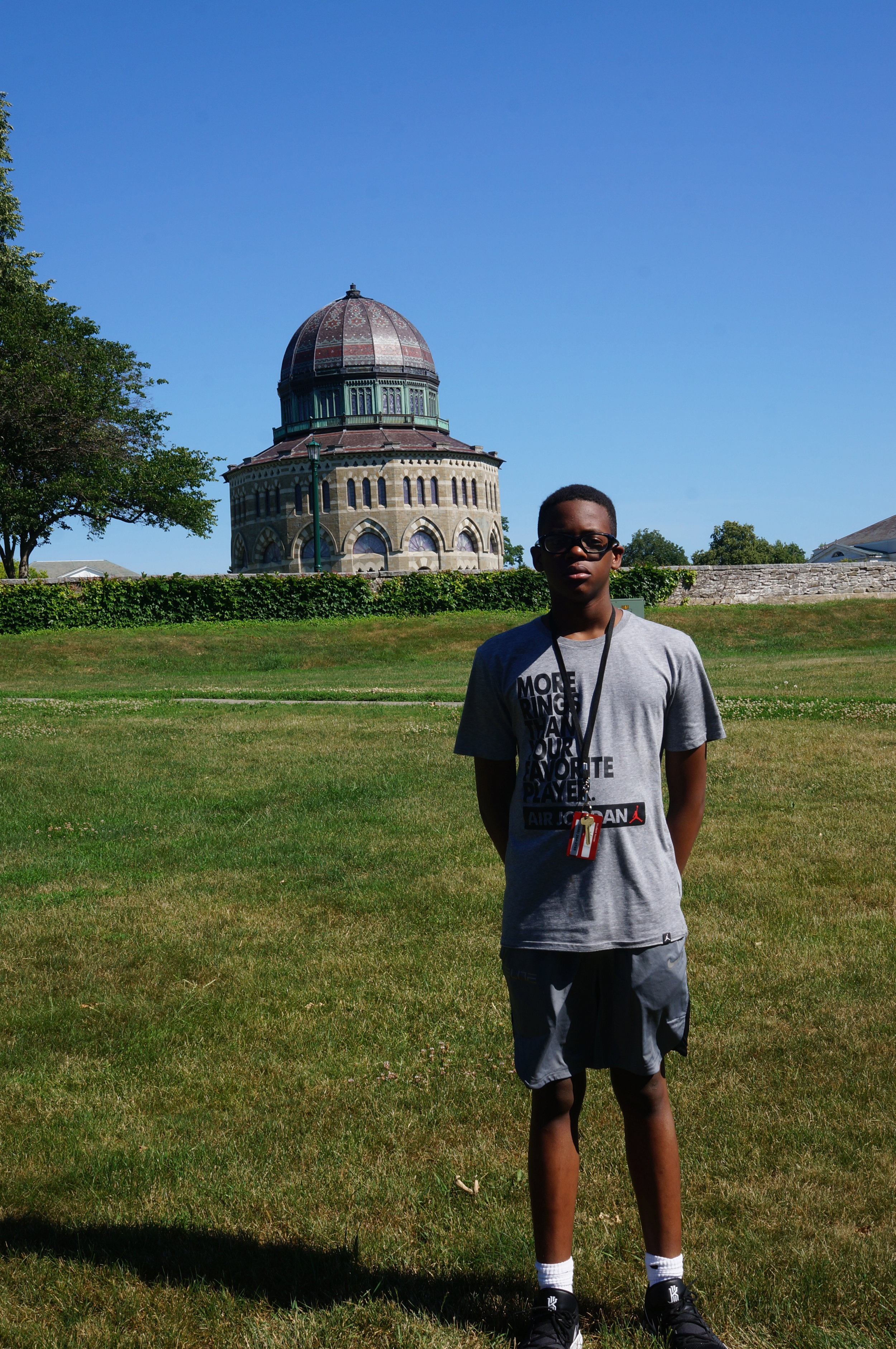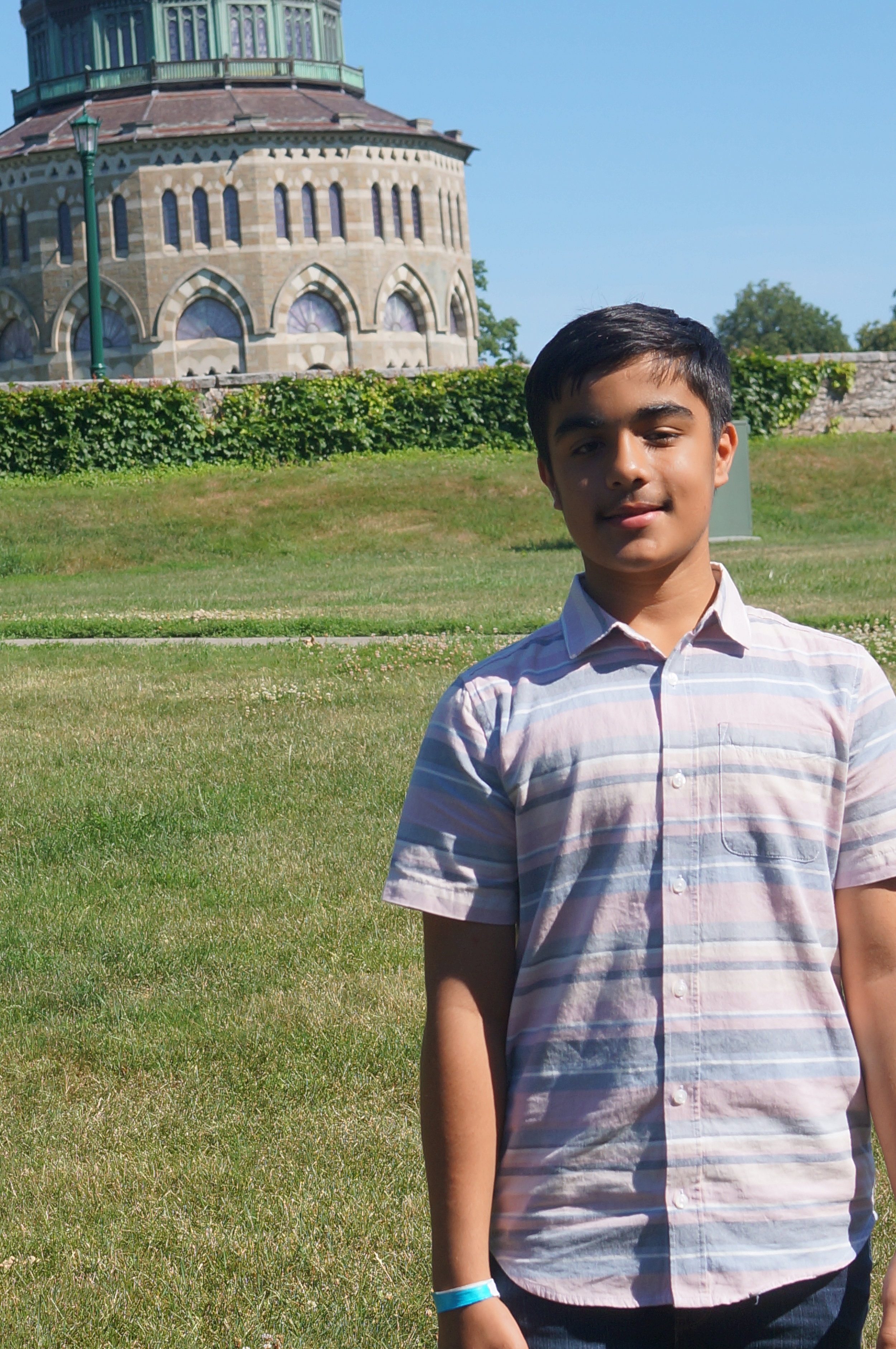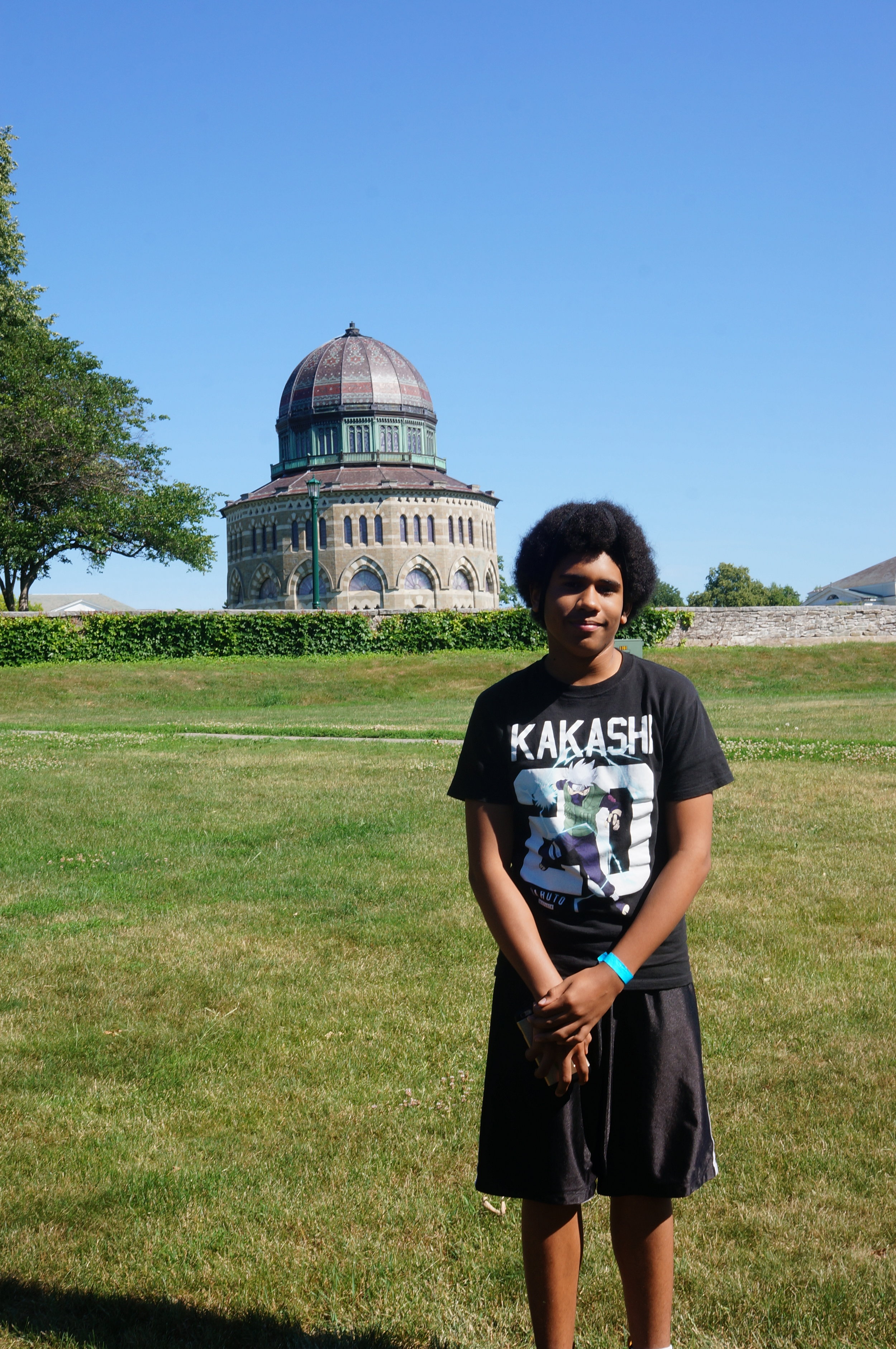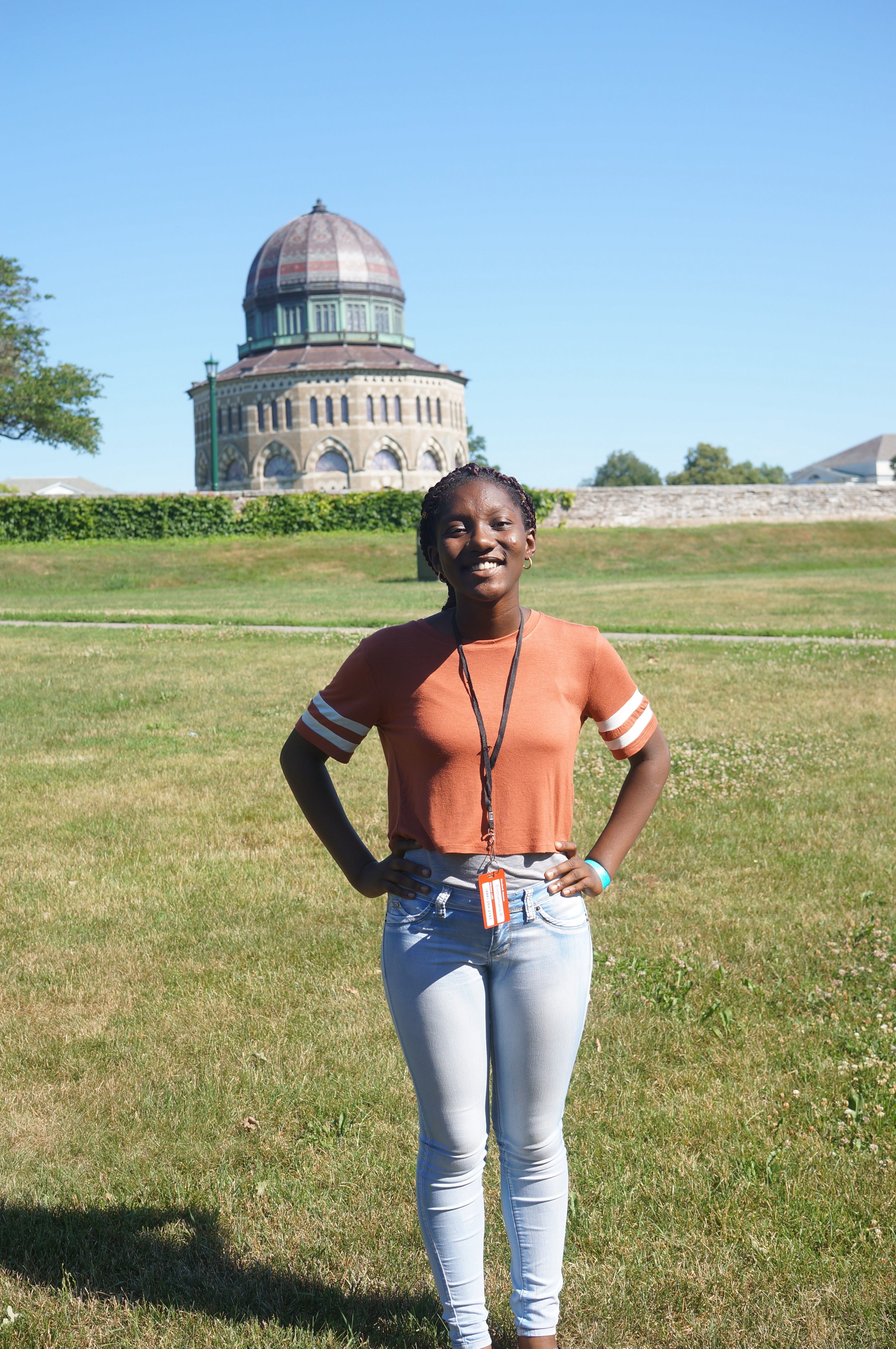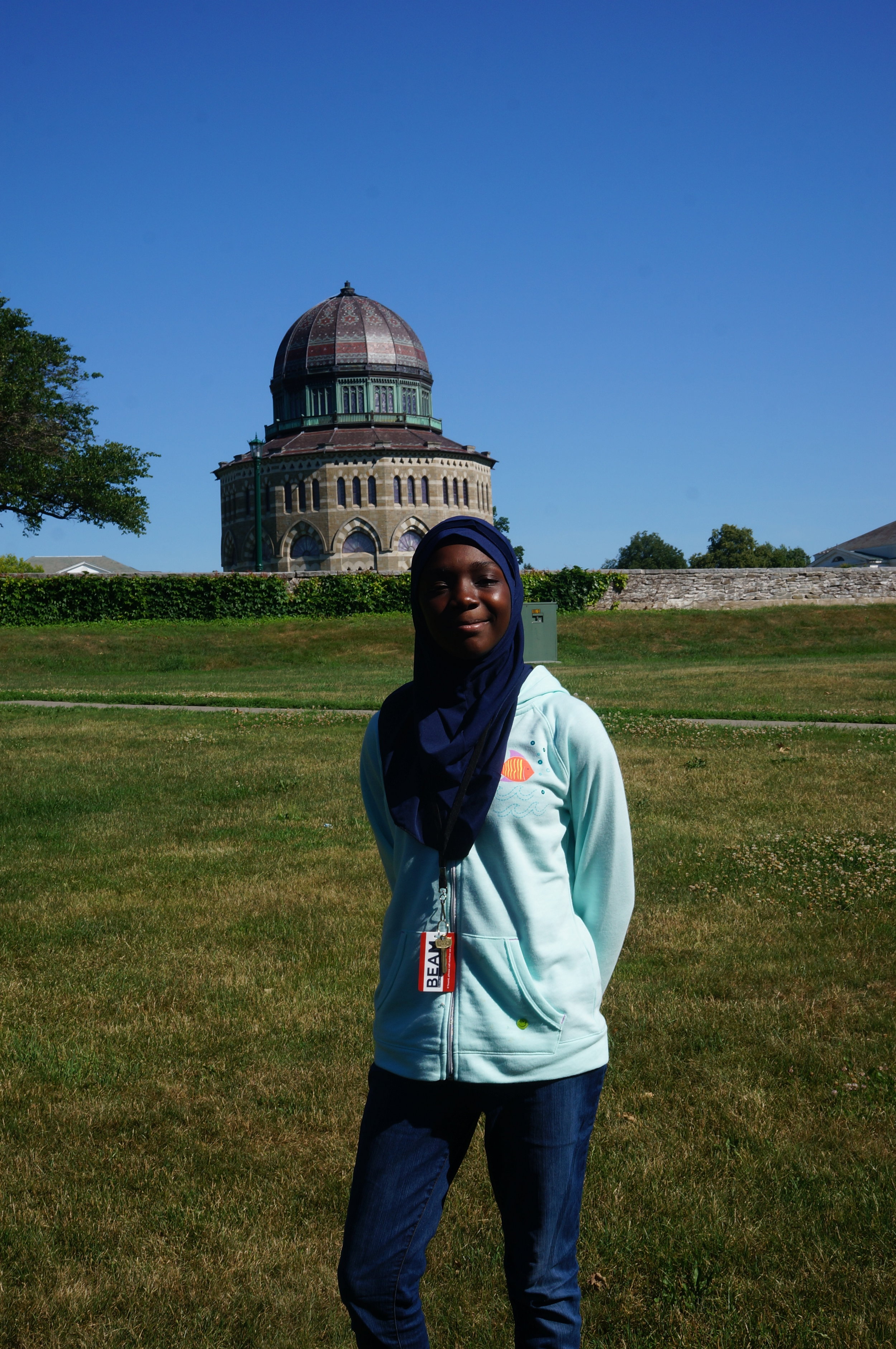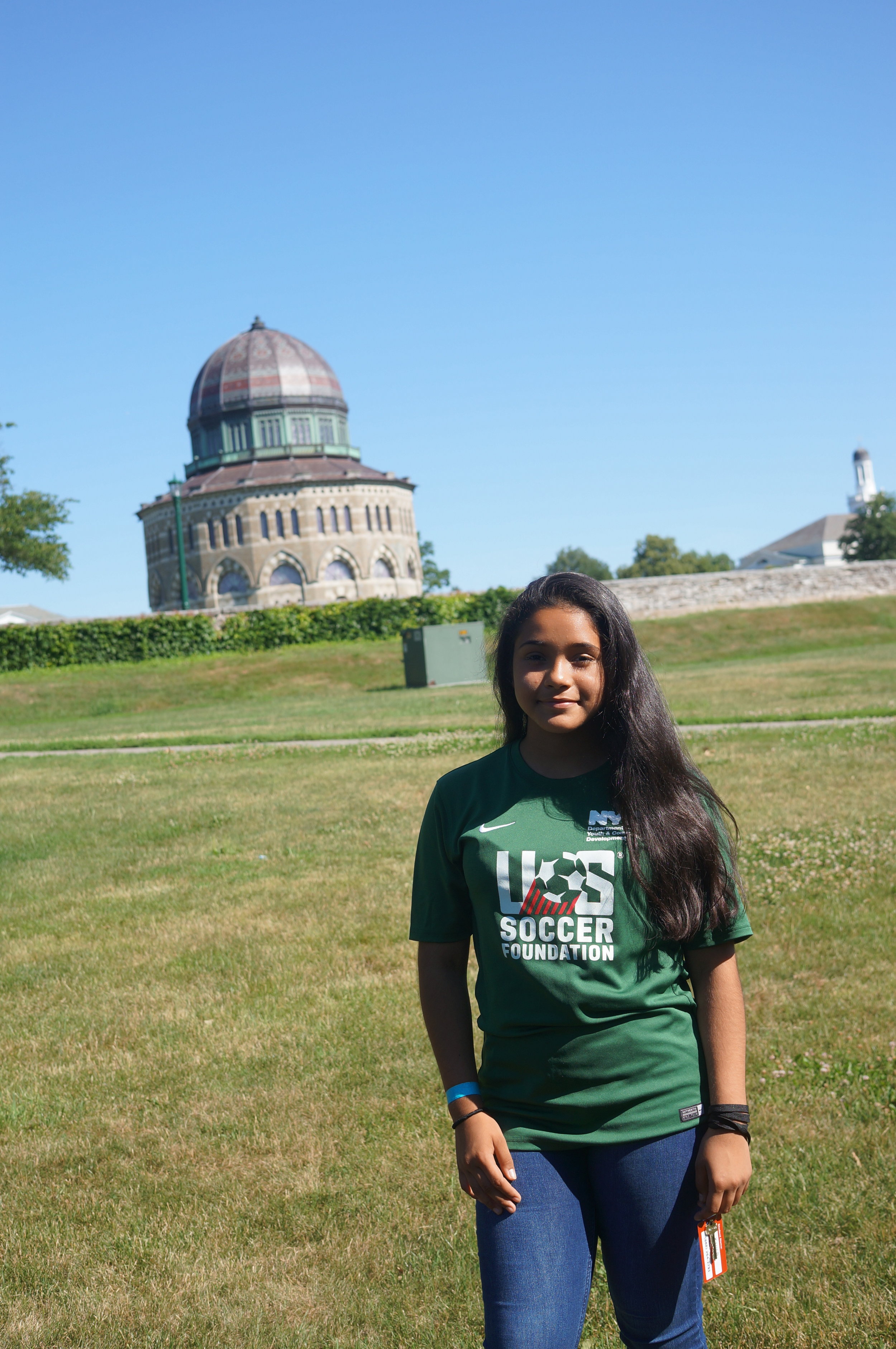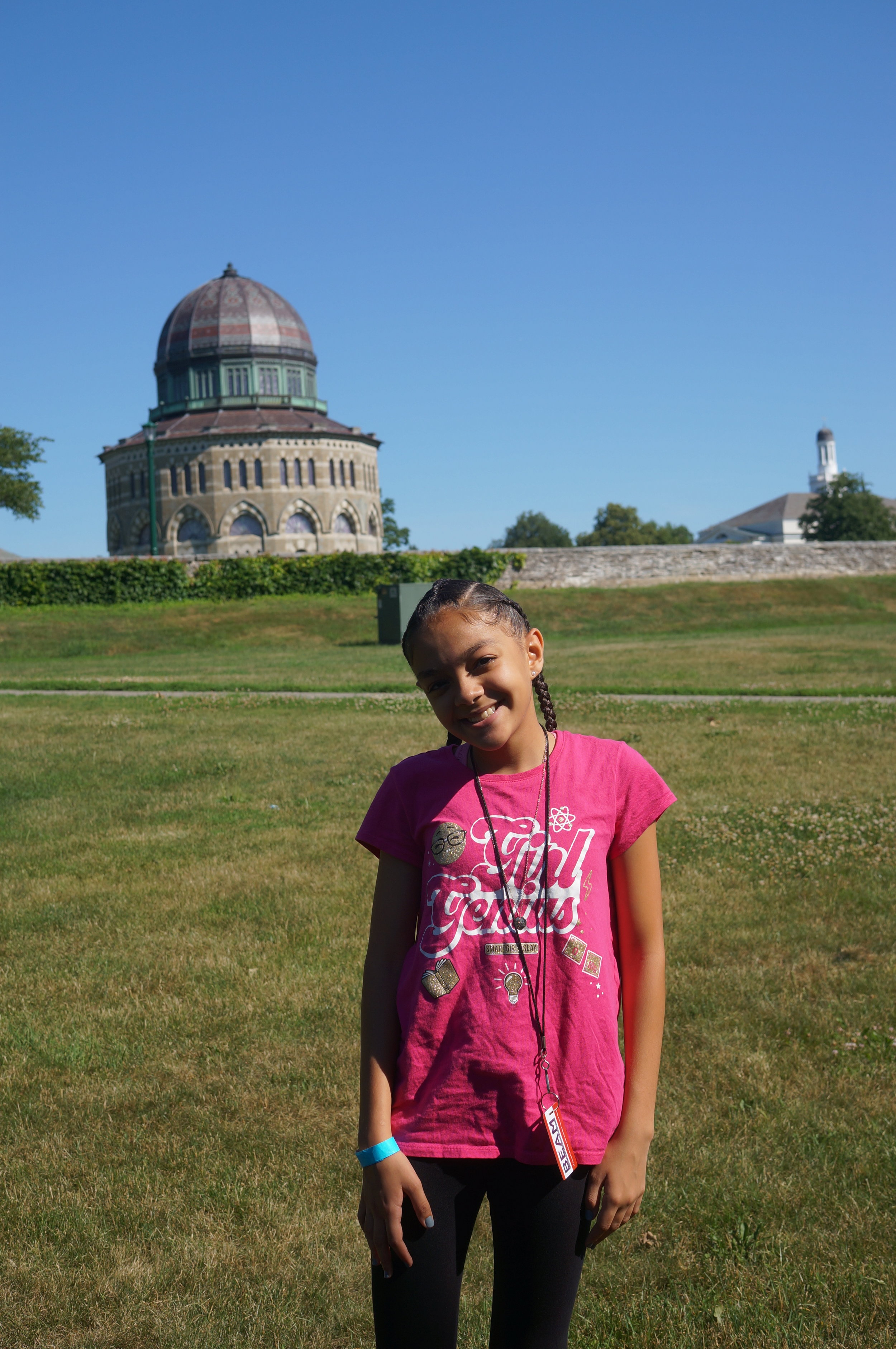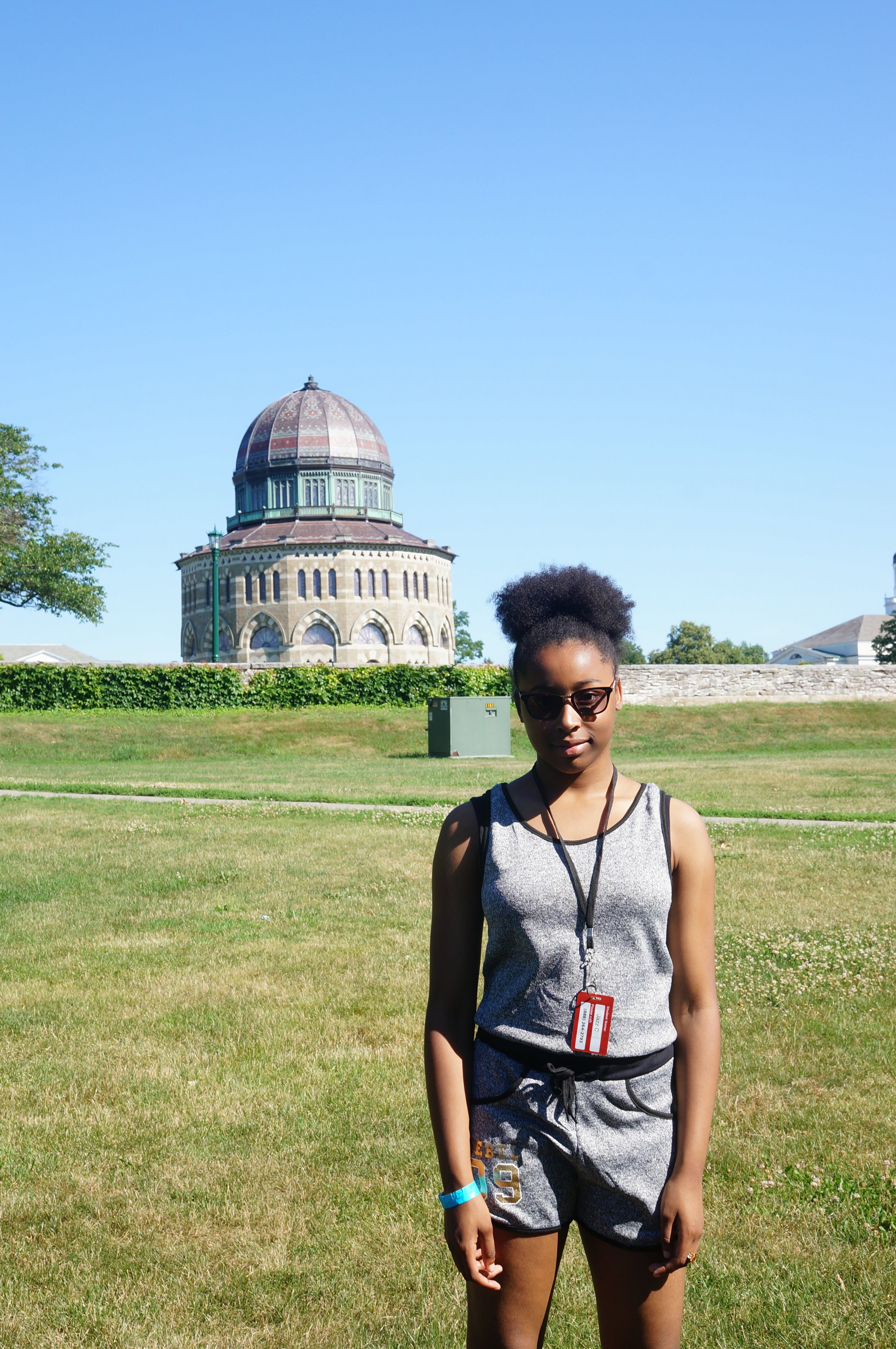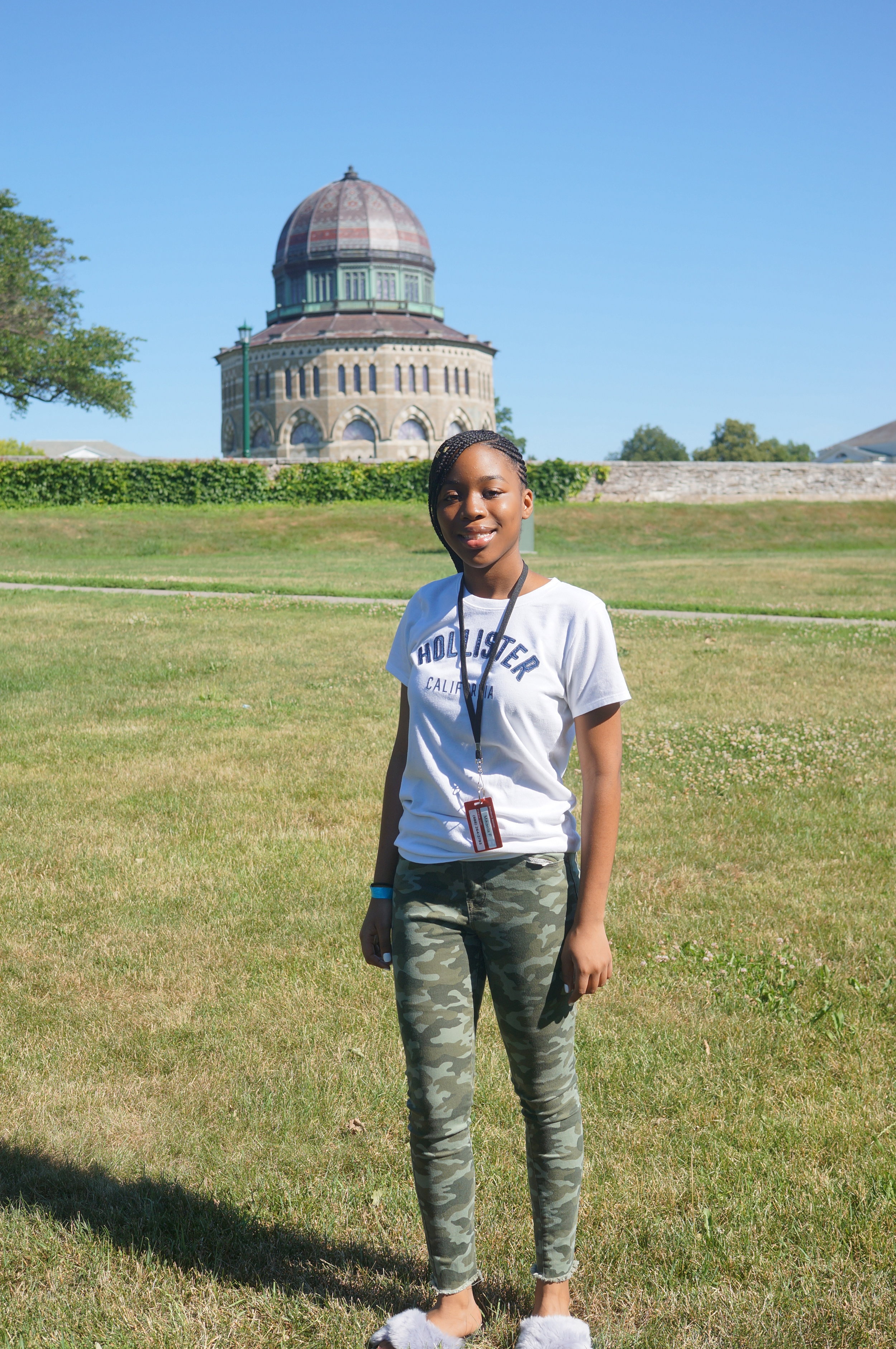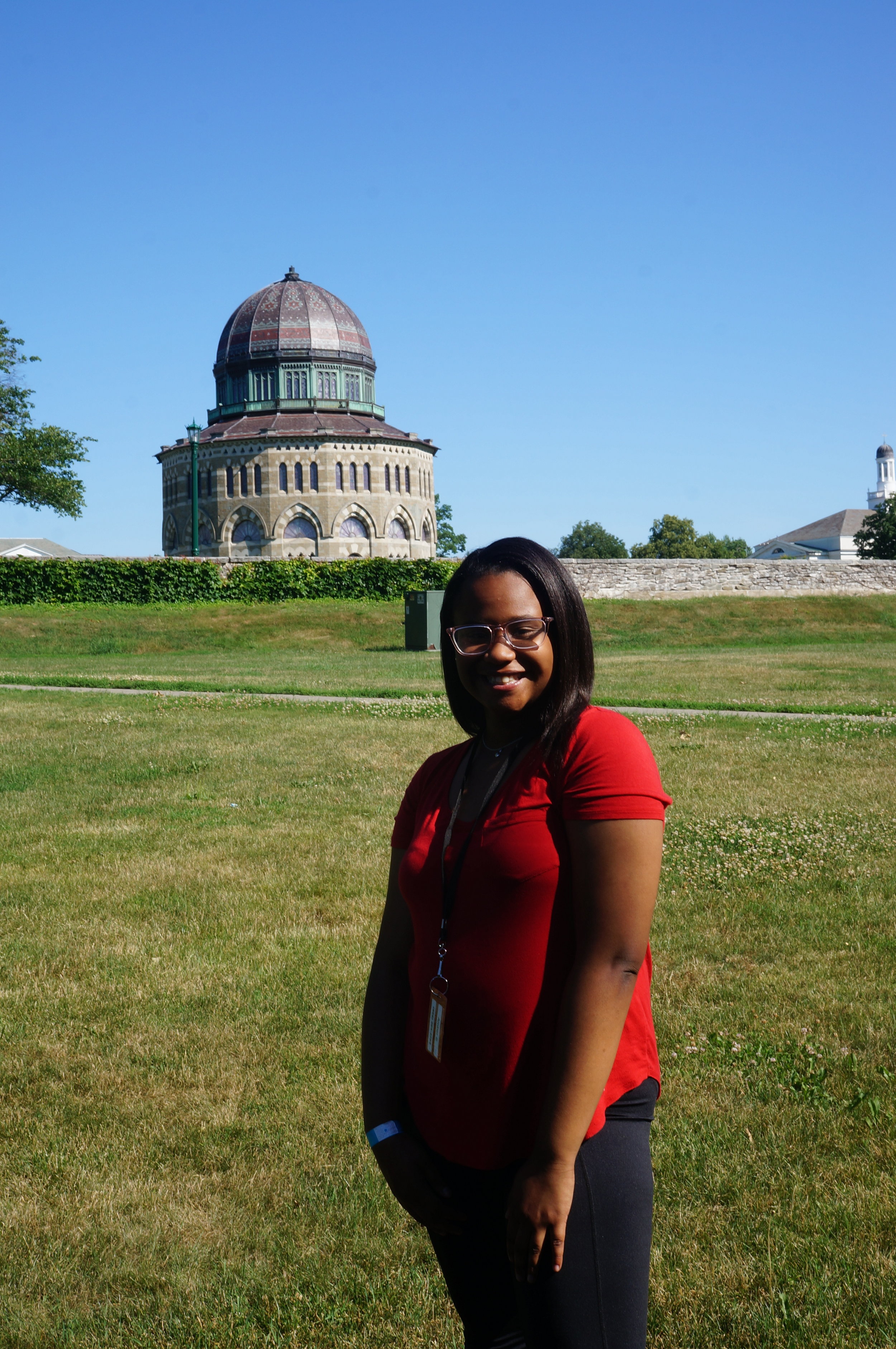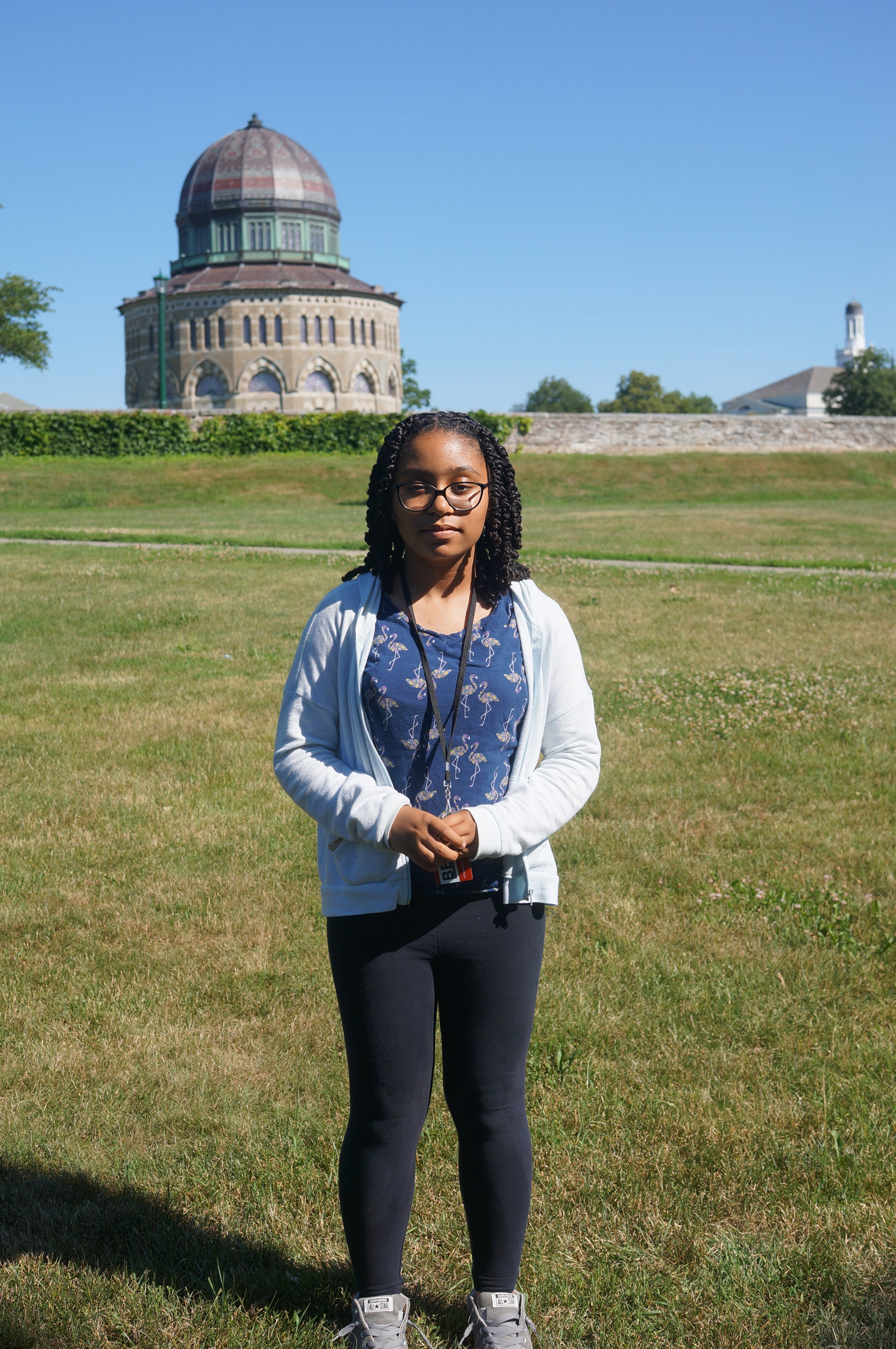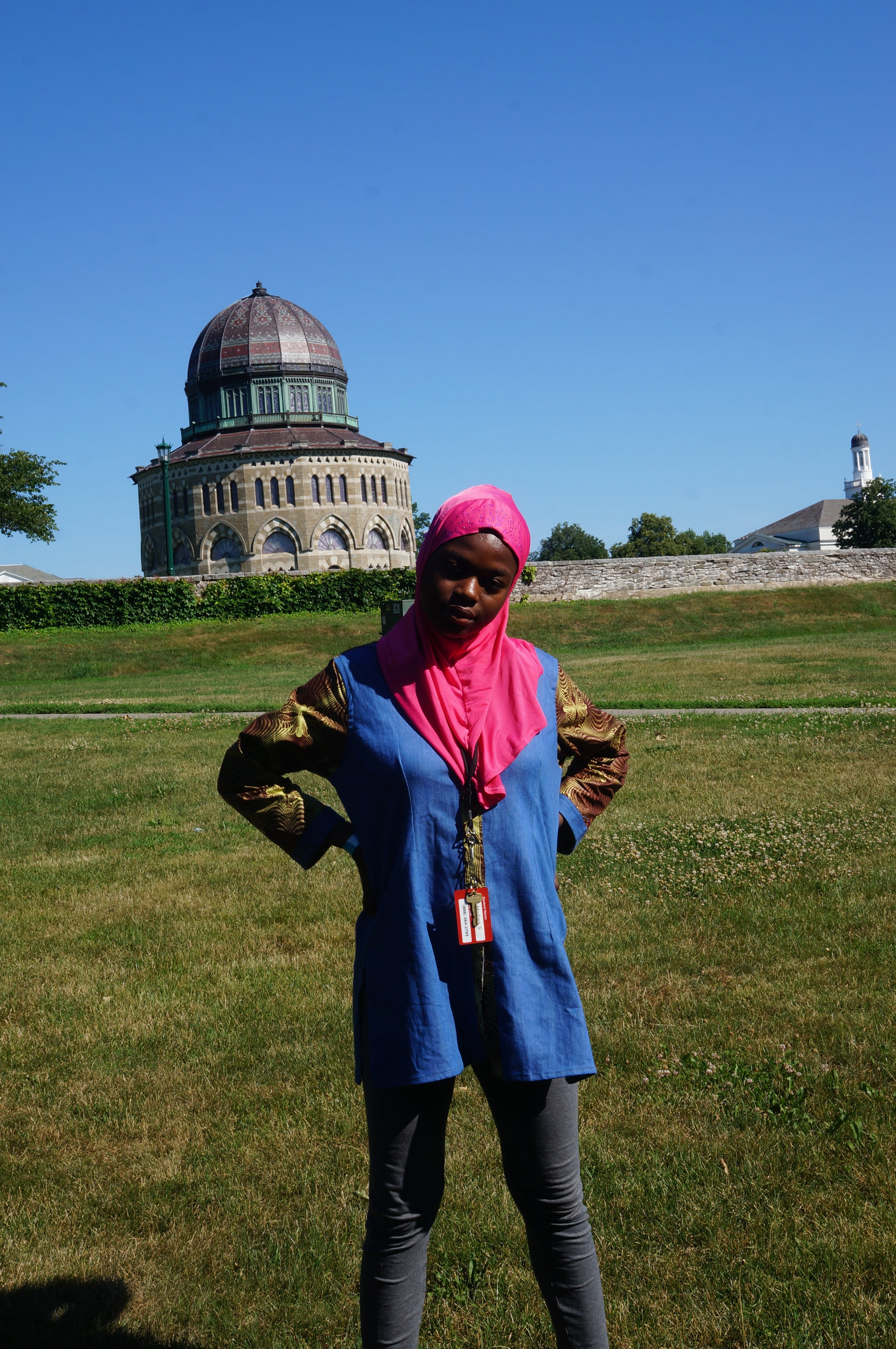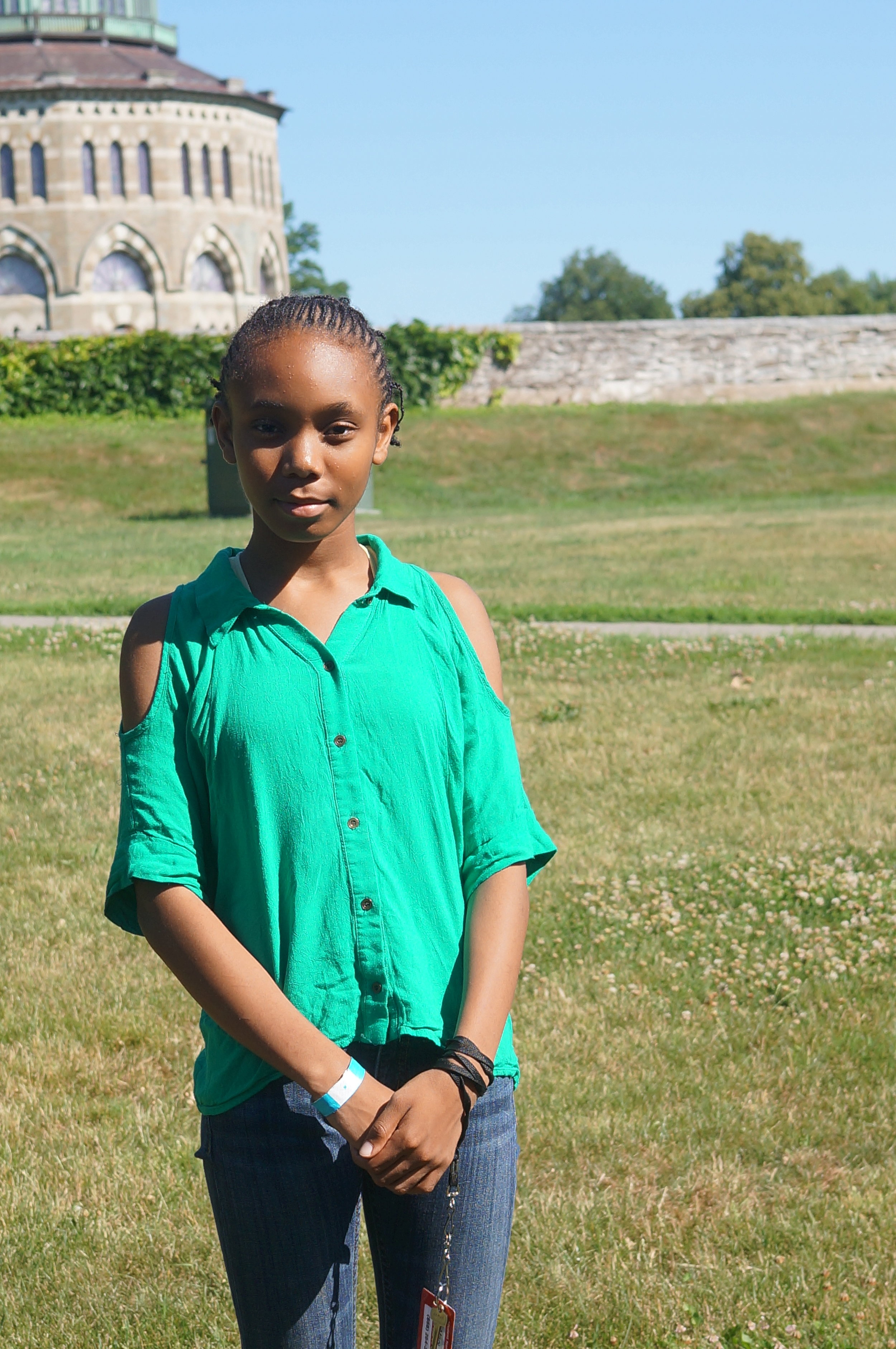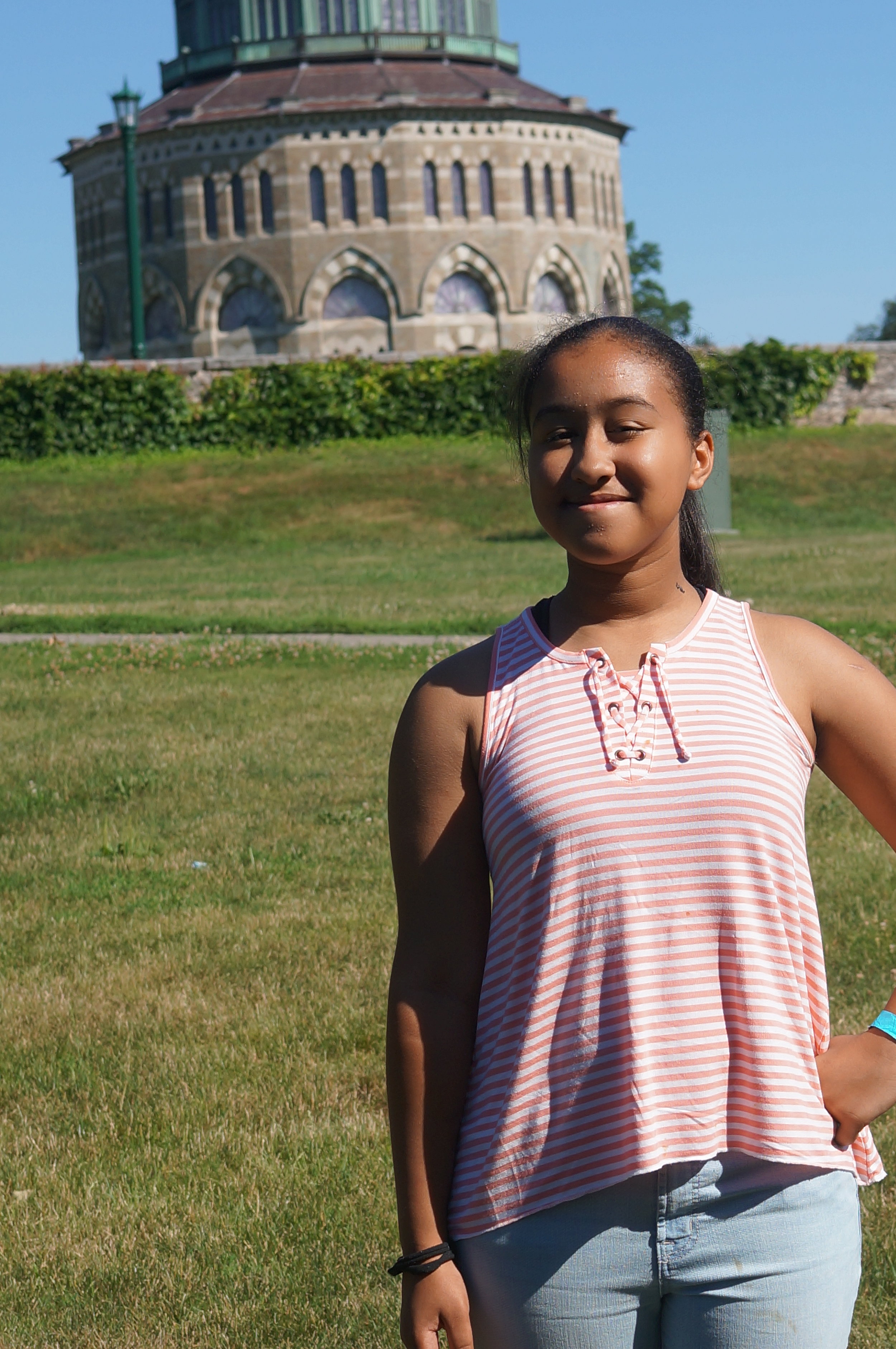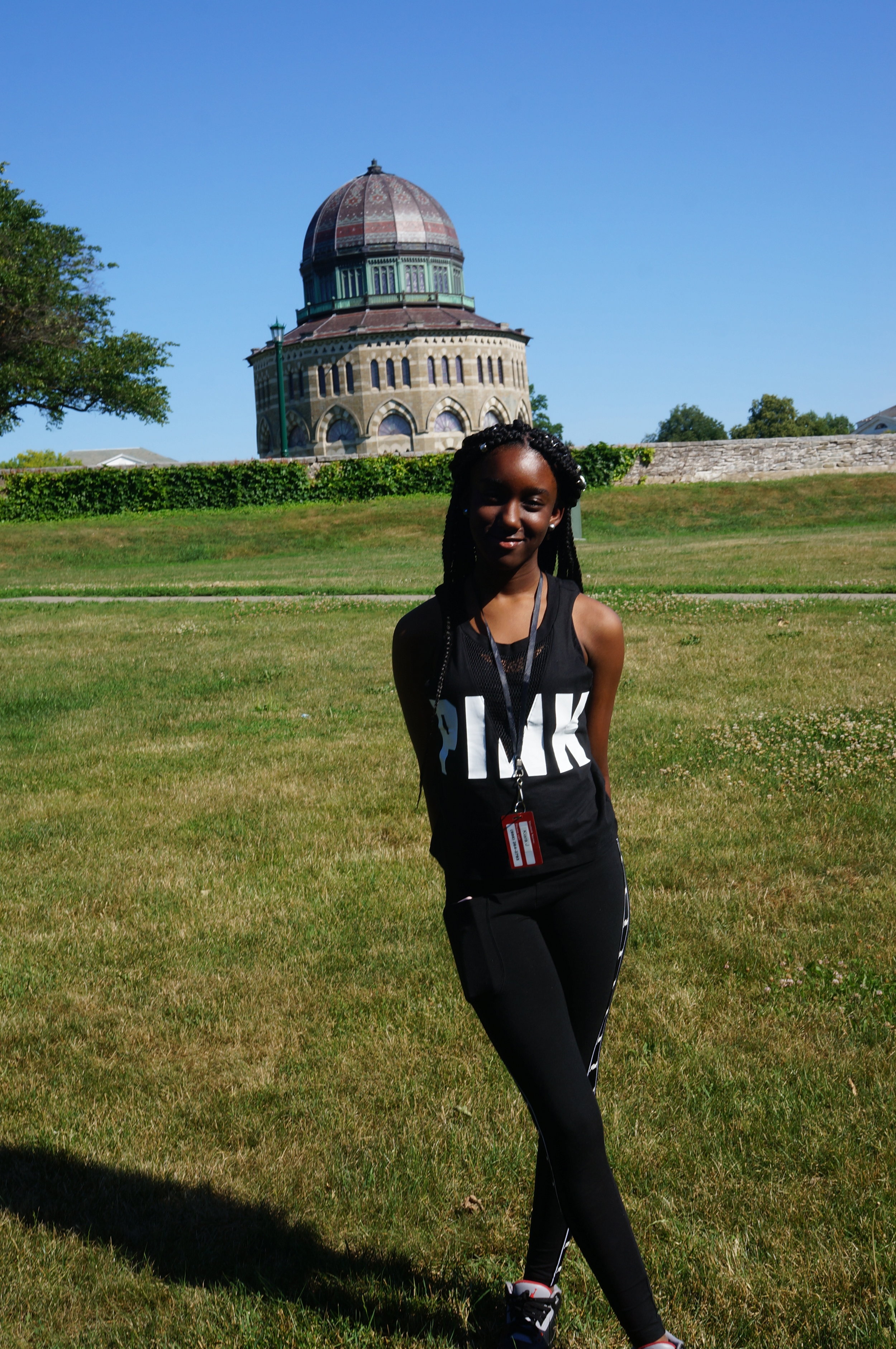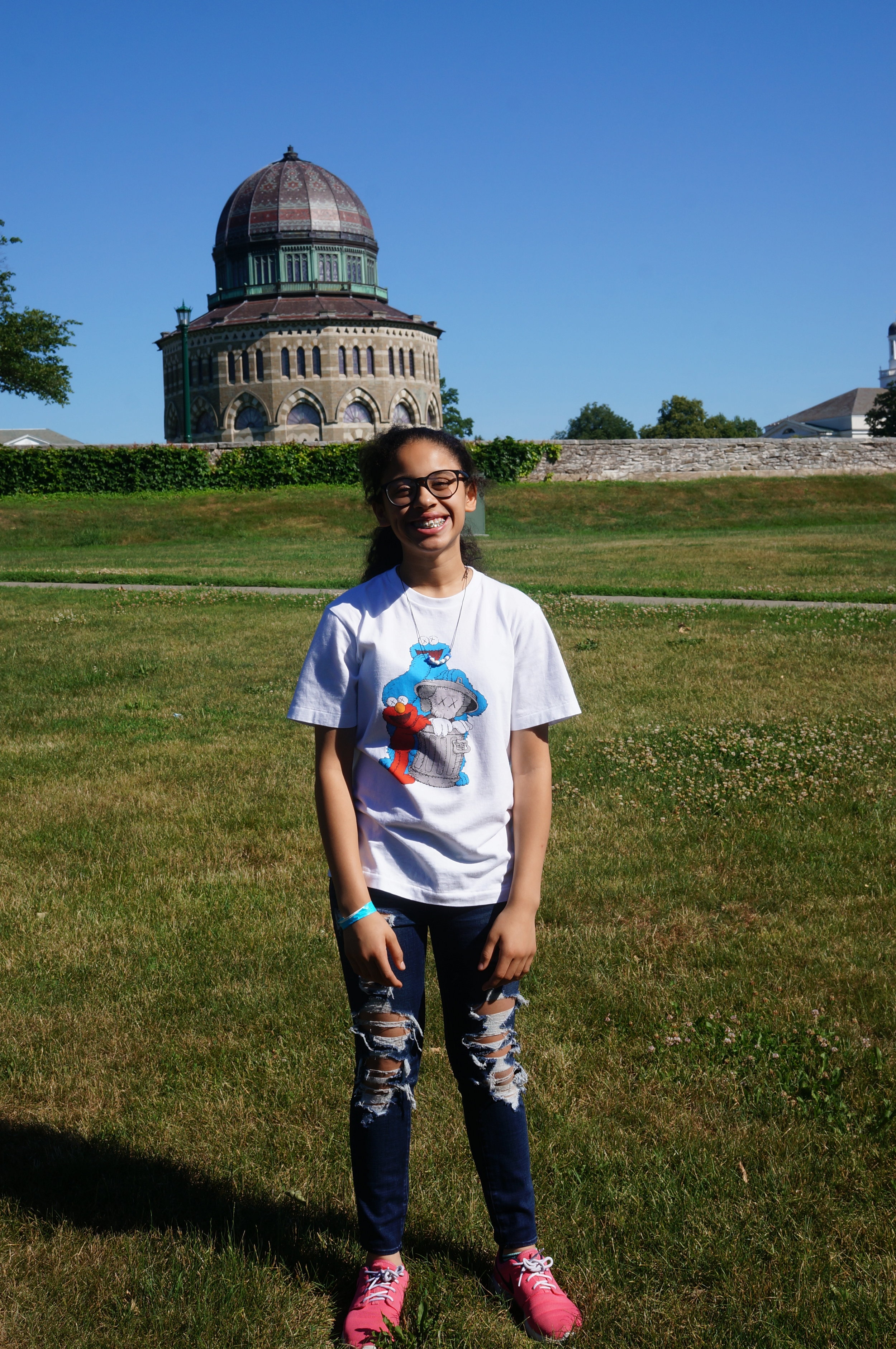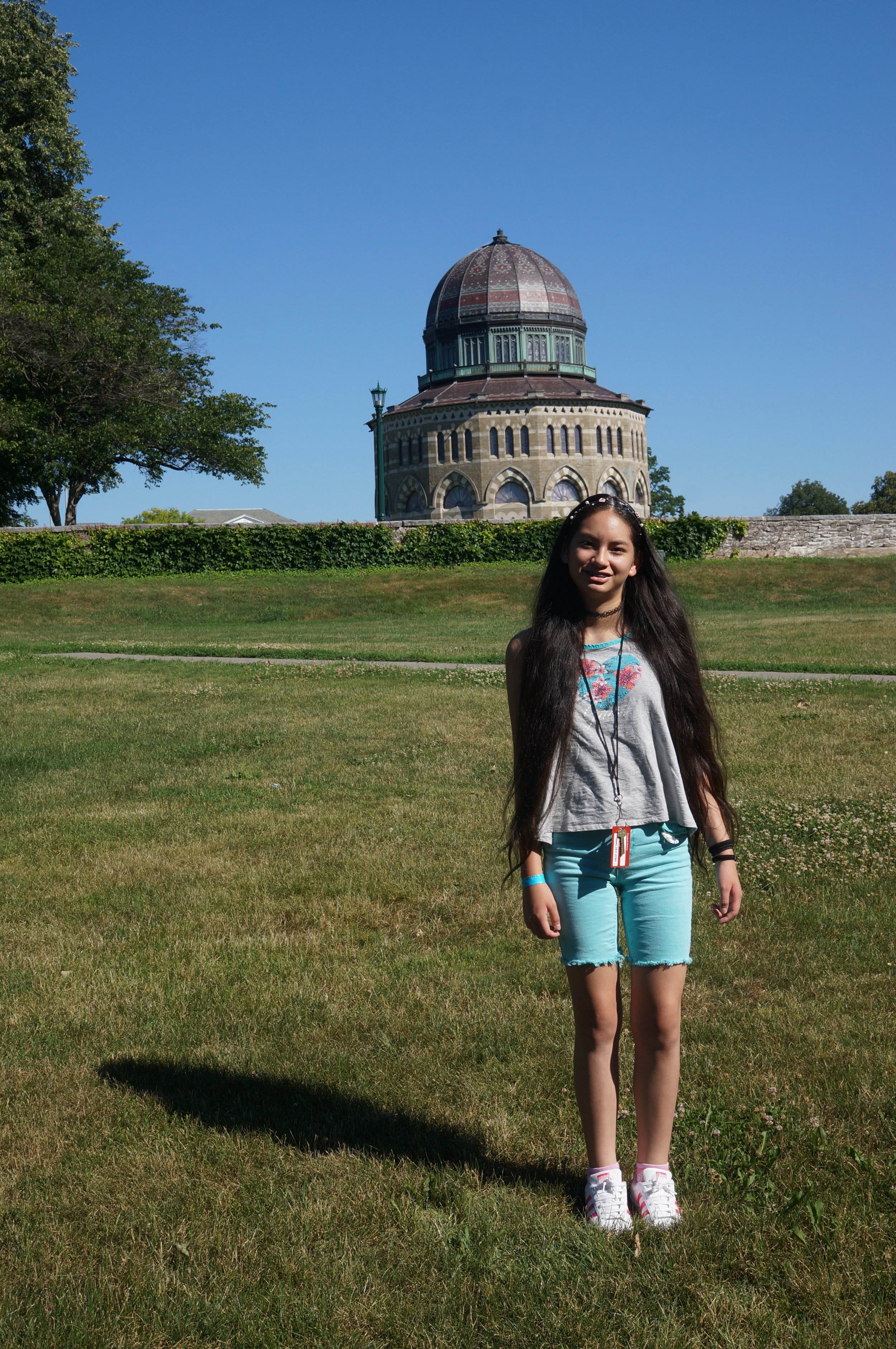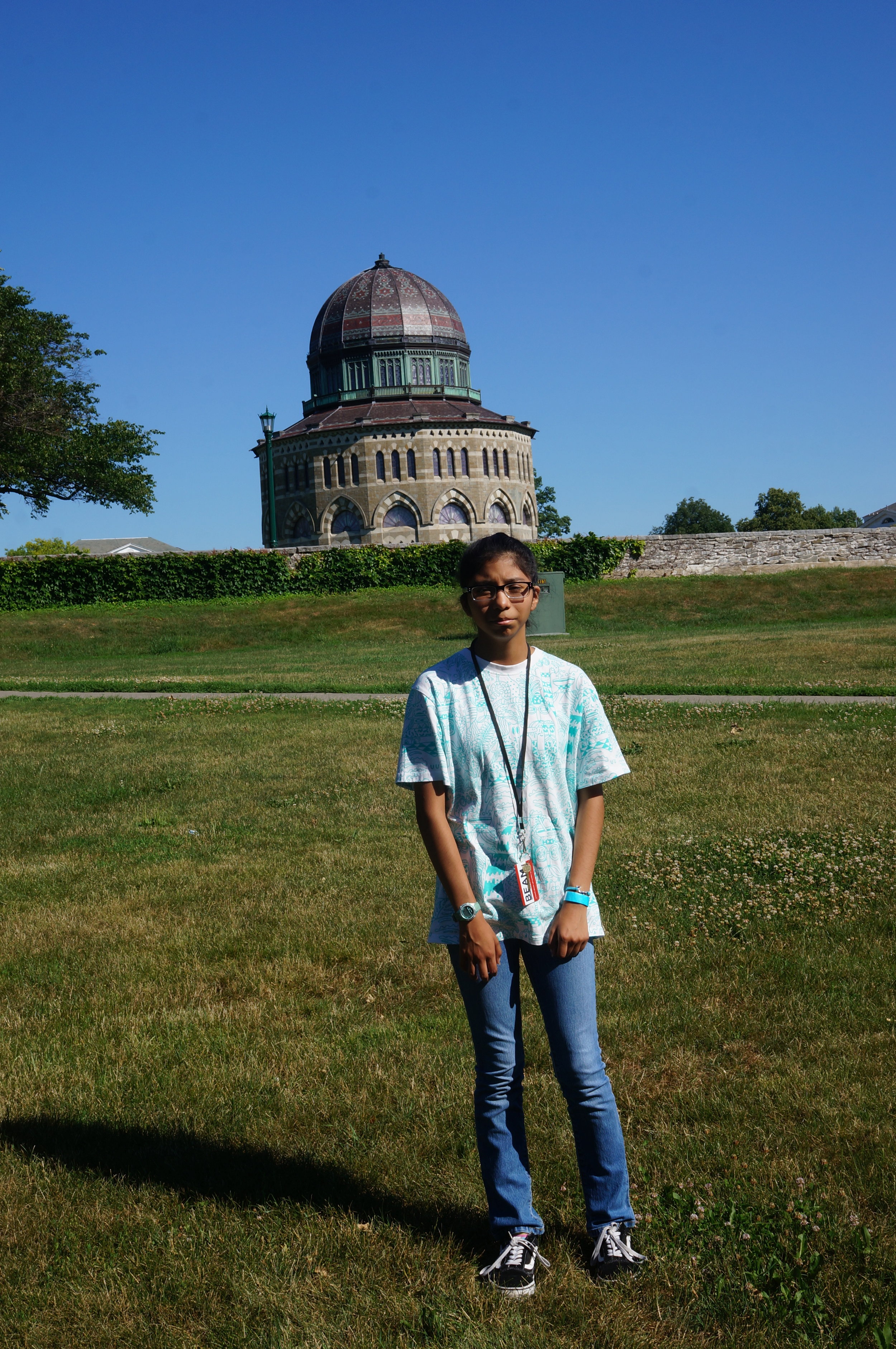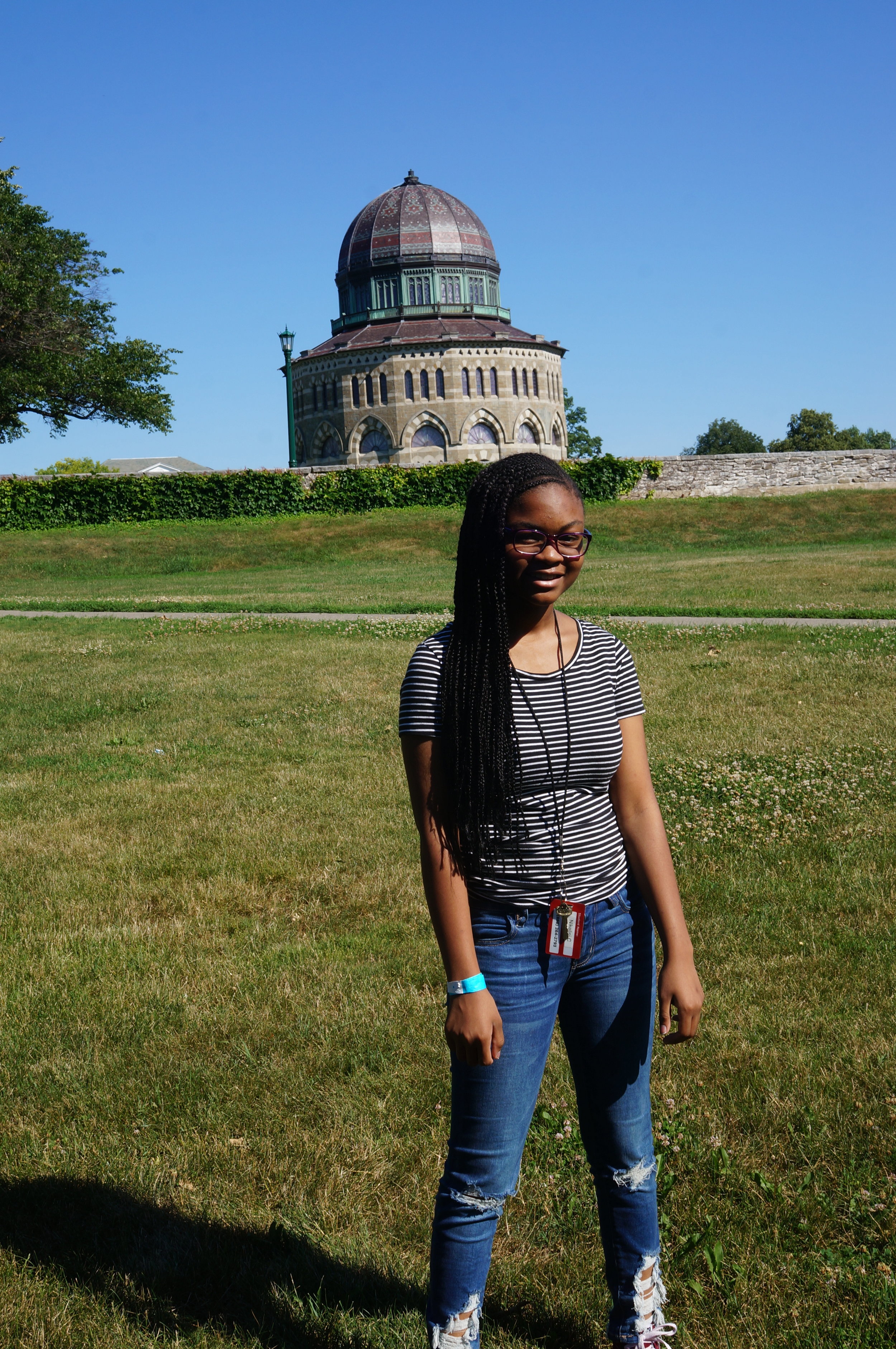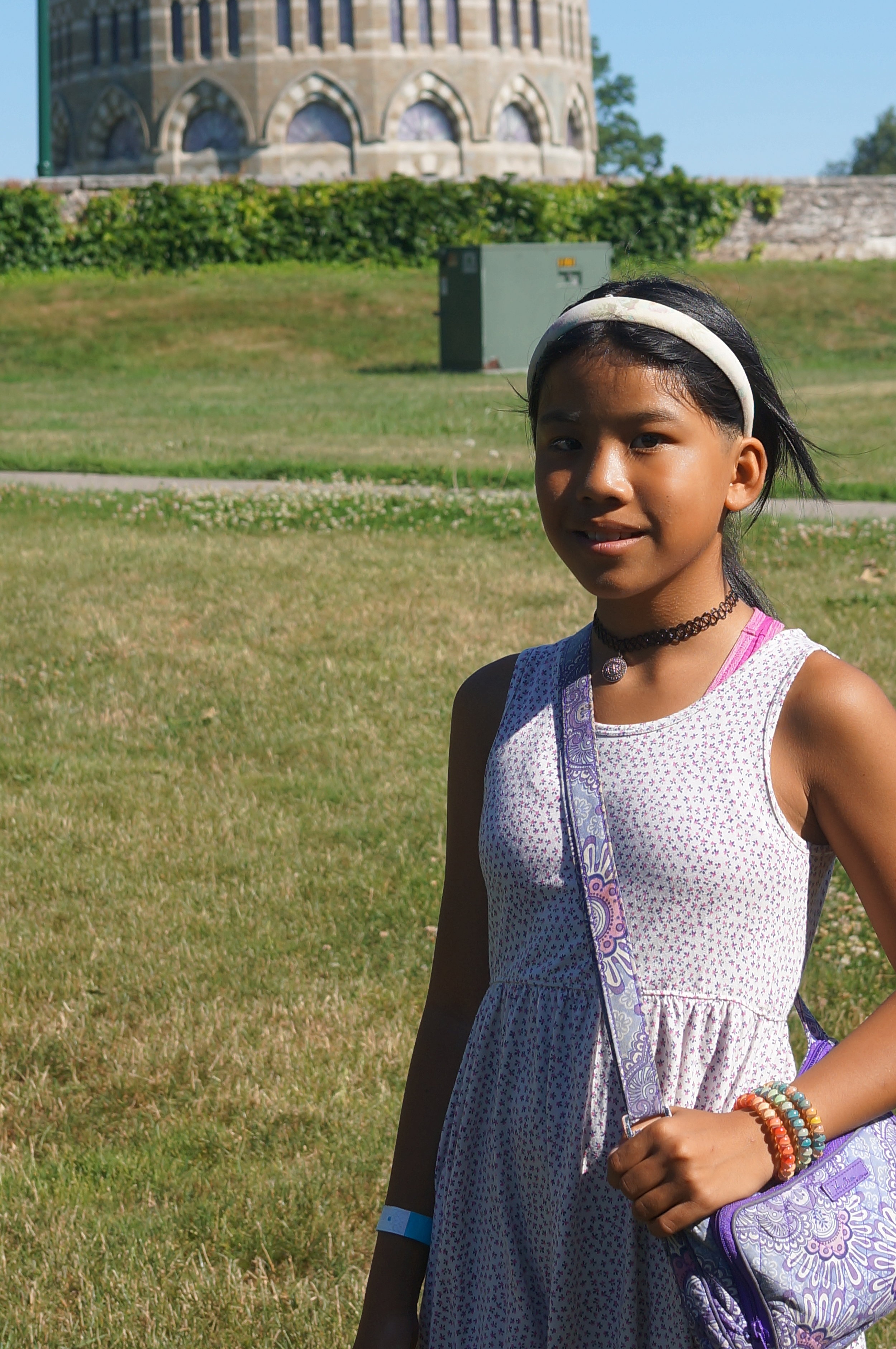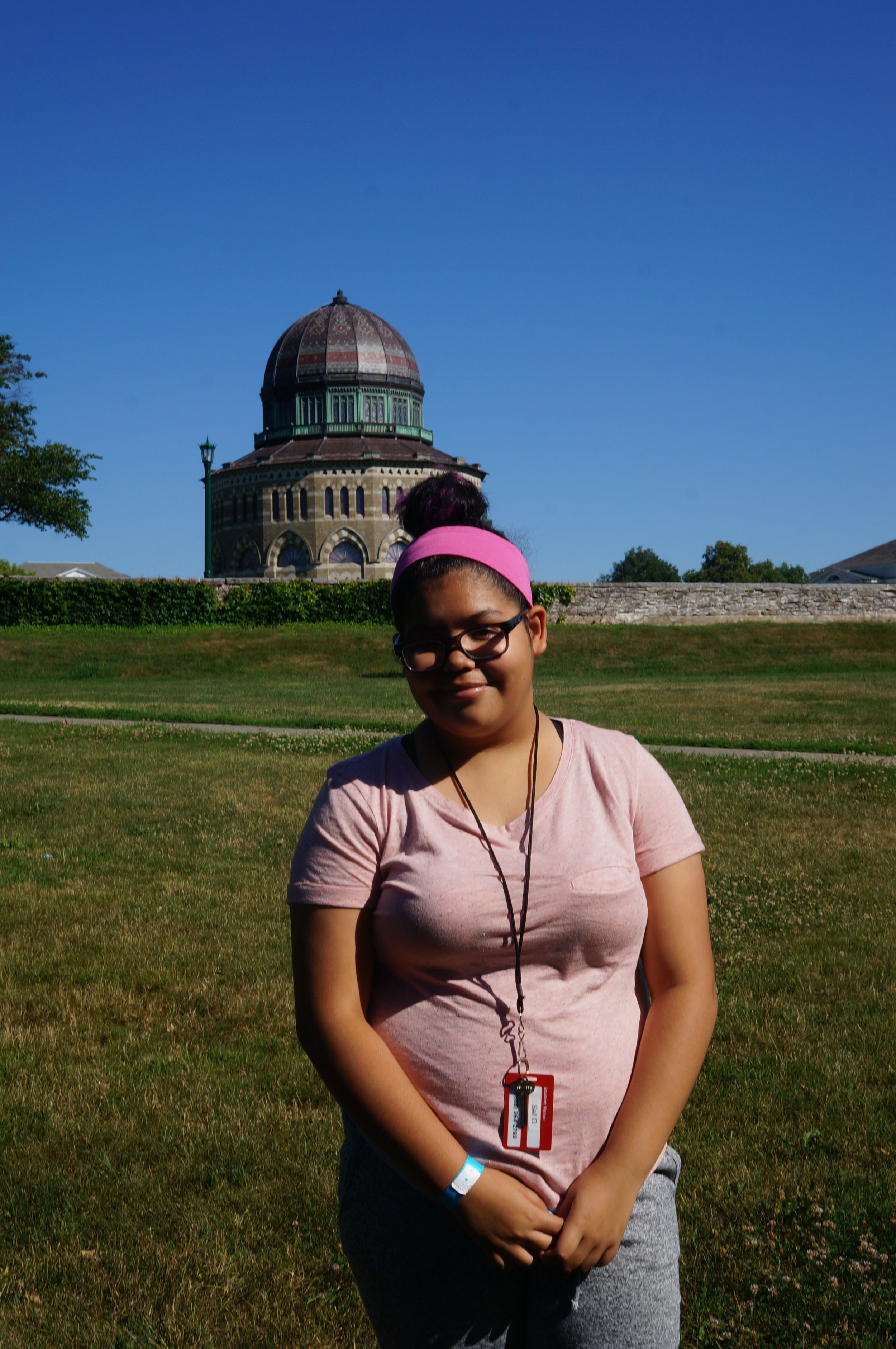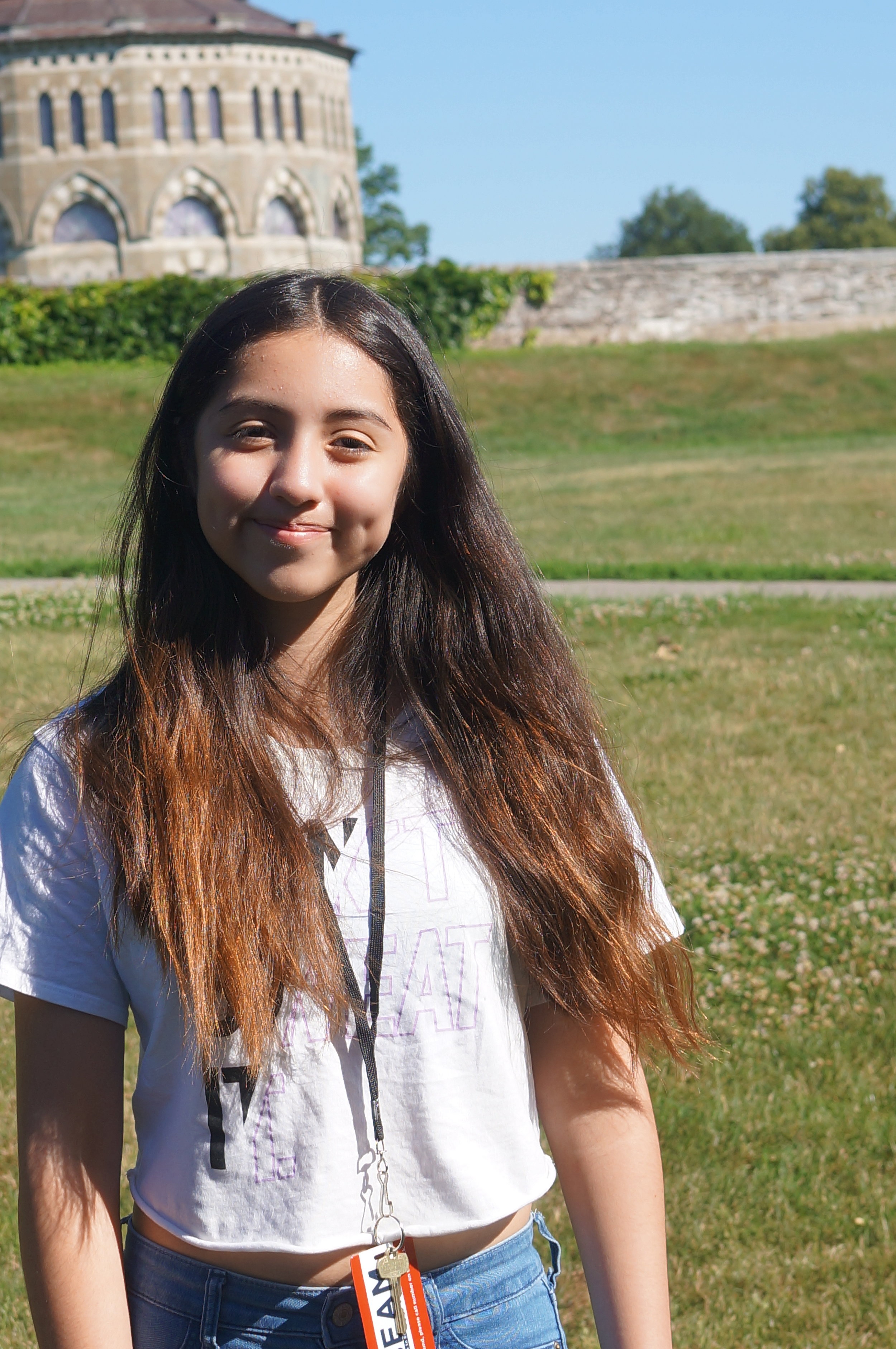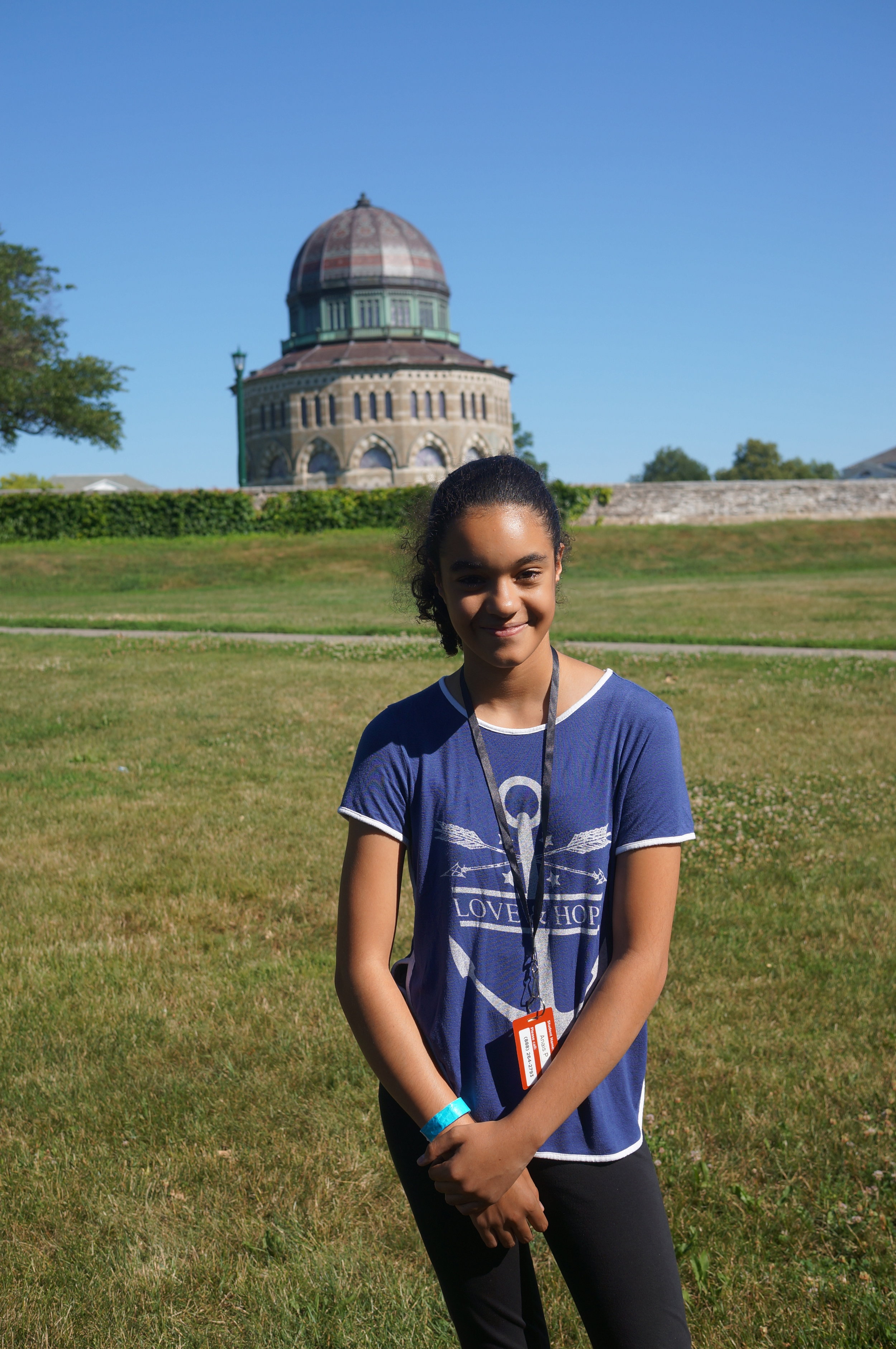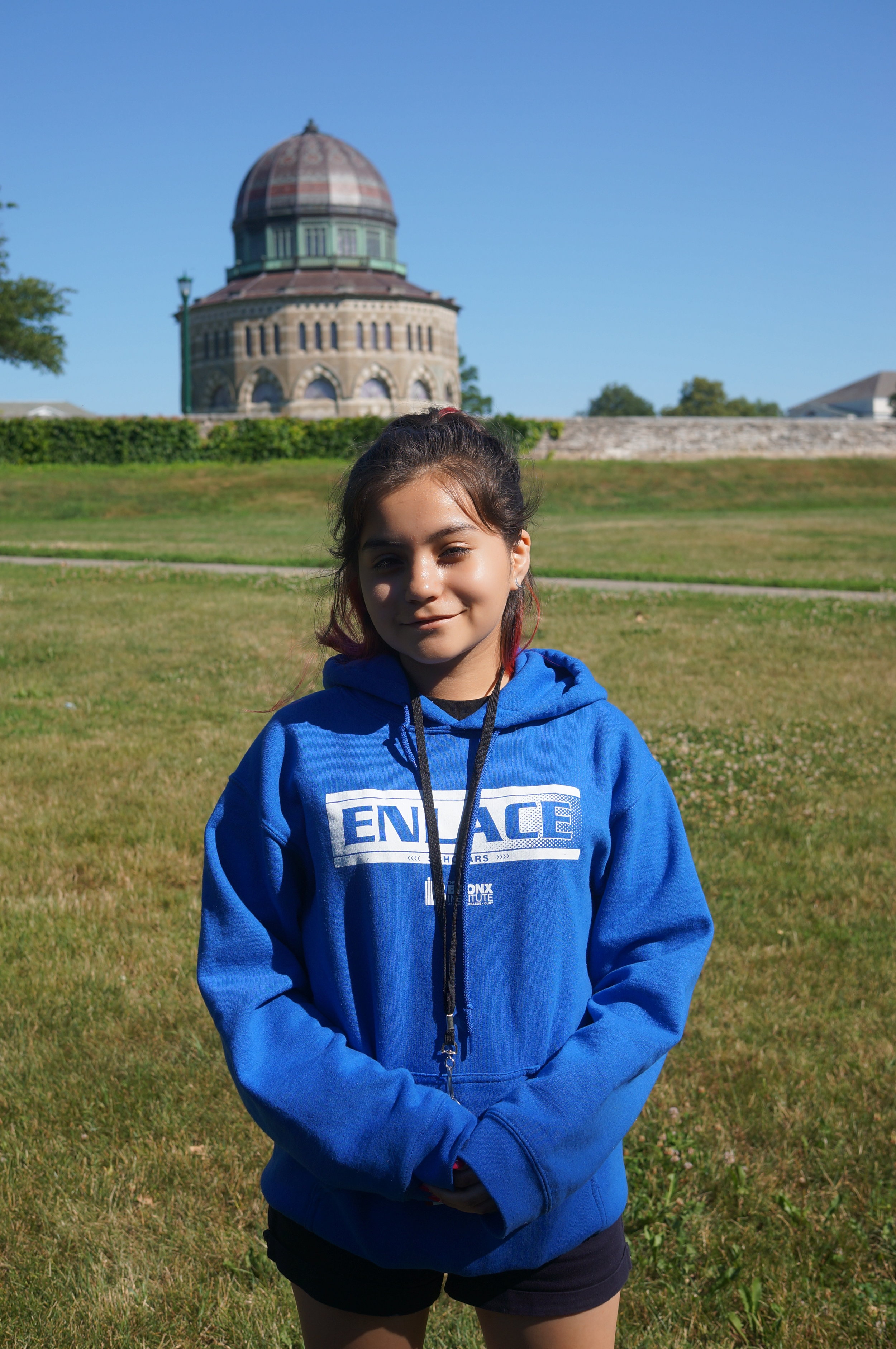This guest post was written by Dan May, a five-time BEAM instructor, who spent a day getting to know Kathy's schedule and thoughts on BEAM!
Kathy on Day 0 in front of Nott.
“I’m working on a problem.” These are the first words out of Kathy’s mouth as she leaves Richmond Hall, the dorm space where 40 BEAM students and 20 BEAM staff live throughout July. A couple of days ago, it was pouring rain on our 8 AM walk to breakfast. A couple of days before that, it was already sweltering by then. But today the morning is perfect as we walk past the majestic Nott Memorial on the spacious campus at Union College.
“The problem is about finding a strategy for how many floors up you can drop a spy device before it will break,” Kathy explains. (Here's a recent TedEd video on the same problem!) In the next breath, she worries about her roommate, Nikelisi, who has overslept just a little this morning. BEAM students tend to look out for each other, especially by the second week, and Kathy doesn’t want Nikelisi to be late for class. “The fan in our room helps us sleep – maybe it helped Nikelisi too much!”
Cassie and Kathy later, on Field Day!
As we enter the dining hall, Kathy mentions that she is excited to tie dye her t-shirt later this evening for her field day team, but our attention quickly turns to the many breakfast options available this morning: eggs, bacon, pancakes, oatmeal, cereals, yogurt, fruit – the list goes on. Kathy enjoys the food at Union, but like many BEAM students, she misses her family’s home cooking.
While we’re taking our seats, a staff member trips and spills coffee and juice onto the table, floor, and himself. Nearby students and adults quickly pitch in to help clean up, and the conversation turns to embarrassment. Kathy mentions that the supportive environment of BEAM makes people feel much less embarrassed about awkward situations than they might in a normal school. “BEAM is like a democratic society,” Kathy says, going on to describe how everyone’s preferences are taken into consideration when making decisions. This is true: Kathy, like all BEAM students, had a voice in choosing the classes and activities that will shape her day, and summer, at BEAM.
By 8:20 Nikelisi shows up to breakfast, completely nonplussed by Kathy’s joking around that she’s late. (Official BEAM policy: 8:20 is most definitely not late to breakfast.) “What’s your favorite weird math thing?” Kathy asks the table. Claire, a first-time BEAM instructor, mentions the number 0.999…... (that’s zero, then a decimal point followed by an infinite string of 9’s). The ensuing discussion is mathematically rich, as several adolescent women debate whether .999….. is equal to one or not. “The numbers .999….. and one must be different,” Jazz insists. “By how much?” Mikaela replies immediately. It’s exactly the right question to ask, and leads to much more debate, but the issue is not resolved during this breakfast.
Eventually the conversation turns back to the challenge problem, and after Kathy decides that her most recent strategy won’t work she throws up her hands and says “I’m done .....” and then after a beat “ ... I’ll continue.” This kind of persistence is common at BEAM.
Kathy’s first class this morning is Analytic Number Theory, taught by Cory, a veteran BEAM instructor who is an assistant professor of mathematics at Washington and Lee University. Cory deserves his title of Dr. but at BEAM we all go by our first names. Kathy likes this arrangement and feels that it helps her create better bonds with her BEAM instructors.
Kathy shares an idea with instructor Cory and her group, Madjara, Sam, and Jack, during Analytic Number Theory
The environment of Analytic Number Theory is intentionally collegiate – Cory trusts his students. They are trusted to choose their own groups to work in. They are trusted to understand complicated mathematical ideas that are not watered down. Cory believes that mathematicians begin to use mathematical concepts before they are completely comfortable with formal definitions, and the students in his class this morning are correctly using fundamental calculus concepts like limits, and convergence and divergence before they know precisely what these terms mean.
Kathy’s group is working on the sequence generated by the function on the right, and trying to determine if there is a number that this sequence seems to be getting closer and closer to. They discuss the problem with their class’s teaching assistant Bobae, a rising sophomore at Harvard. It’s clear the students have already absorbed function notation, and they are discussing with her how different choices of domain might affect their answer. Someone prematurely declares that they’re “done” with the problem, to which Kathy replies “you’re not done if you don’t understand it!” Everyone agrees with this, and they continue on with their work.
Once they’ve decide to expand the domain past {1, 2, 3, 4, 5} into the set of positive integers, Kathy claims that the answer should be 0. Her reasoning? “The denominator increases while the numerator stays the same, so the answer gets smaller and smaller. Zero is nothing, but this function always gives a fraction of something. The space between the numbers is getting smaller and smaller. So they get close to zero but never get there.” Her group mostly agrees with this assessment – perhaps they remember a similar line of reasoning they saw in a problem in Modules, a quiet, late-night mathematics activity.
After the two-hour block of Analytic Number Theory with Cory, it’s time for the first of two scheduled activities. Today Kathy is playing board games in the Union Student Center. Underneath a high, vaulted ceiling of skylights, students spread out across several tables in a large and inviting space, illuminated with late-morning natural light. This year, students’ favorite board games have included Monopoly and Life, but today we’re learning some lesser-known games. Soon lively matches of Tsuro, Blokus and Niya are underway. And Coup. Coup is a card game in which players assume various personas, including the Duke, Assassin, Captain, Ambassador, and Contessa. By carefully deploying these characters’ skills, players can outmatch their opponents. Or you can just lie a lot. At any point in the game, any player may be bluffing about their true persona. So the game rewards strategy, but also deception, and matches usually become very animated. On this occasion, Kathy attempts to wield the powers of the Contessa – a dangerous gambit that doesn’t end well for her when her bluff is called and Kathy is eliminated from the match.
Kathy plays Coup with staff Don, Claire, and Ayinde as well as students Jade and Andrew
But everyone has fun, and now it’s time to head upstairs in the Student Center for lunch. Kathy’s run of bad luck continues: the current challenge problem has been cancelled. This is a rare occurrence at BEAM, but when the community of students obtain information on a challenge problem in an unauthorized way – well, it’s time for a new problem! Kathy takes this unfortunate piece of news with her characteristic good humor. She even takes an electronics warning in stride. Kathy is an avid music fan, with tastes that run towards songs addressing weighty social topics, and she has been sharing her headphones with a fellow student over lunch. But BEAM has a strict no-electronics policy from 9 AM to 7 PM every day – we’re all here to grow and we believe an essential aspect of that is to be present with each other instead of our devices.
None of this dampens Kathy’s enthusiasm for heading back to Analytic Number Theory for two more hours directly after lunch. During this class period, Cory introduces the class to some very formal and very essential calculus notation:
They spend careful time picking apart each piece of that mathematical sentence. What does “lim” mean? The right-pointing arrow? The students mostly have seen the infinity symbol before, but the use of the equals sign is especially tricky. Like Kathy had said in the morning class, the elements in the sequence will get close to zero, but they will never get there. So how can anything equal zero, she wonders. These are the kinds of questions any college freshman should be considering closely when they first encounter this idea, but frequently they don’t have time to. Eventually, Kathy gets it. “Oh, we’re saying the limit equals zero. Not any terms in the sequence.” This is a breakthrough.
TA Bobae oversees Kathy and her group, Madjara, Sam, and Jack, as they work
Fitz and Zeina play "It's Tuesday!" during an improv activity
Between afternoon blocks of class, students have another scheduled activity period, and an opportunity to have a snack. Kathy’s afternoon activity today is Improv with Hector, another Counselor/TA who is a recent graduate of Rochester Institute of Technology, starting a PhD program in mathematics at Lehigh University. Kathy is delighted by how silly some folks are while acting out their roles: “How are you going to act out an emoji?!?!?”
The third two-hour block of class in Kathy’s day is a class called Solving Big Problems (SBP), where students ..... solve big problems. These are math problems designed to take two hours (or more!) to solve. Kathy’s instructor is Claire, a seventh-grade teacher in Brooklyn (and the .999….. fan from breakfast). Claire does a thoughtful job of helping the students to focus at the beginning of her class. By now it is 4:15, and these twelve and thirteen year olds have been going non-stop since 8:00 this morning (or earlier), and have already spent four hours of very taxing math time in the classroom. Claire’s experience with students of this age is evident. She asks them to spend a few minutes in silent consideration of a photograph of various sizes of pizza pans; each pan is labelled (in the actual photograph, by the pizzeria) with various geometric and pizza-metric information, and the students are asked to generate questions and observations. The students had come into the room a bit disorderly, but they are definitely now focused and ready to go.
Another student, Brandon, works on the problem of the day
Claire introduces the “big problem” for the day – which is actually a complicated question from the mathematical field of graph theory. A graph can be thought of as a network of connections between pairs of objects, and is depicted by a diagram of points (“vertices”) and lines (“edges”). A graph is considered “graceful” if its vertices can be labeled in such a way that generates a labeling of the edges in which every edge gets a different label. The BEAM students have been asked to determine whether certain types of graphs are graceful. A variant of this question is actually an open problem in mathematics – Claire has her students working on a problem that professional mathematicians don’t completely know the answer to!
Another group wrote this about star graphs: "All star graphs can be gracefully labelled as long as there is a 0 in the middle"
But that doesn’t deter Kathy, and she conjectures within minutes of hearing the problem that all “star” graphs are graceful – you just have to label the “middle” vertex with zero. (To be clear – this is not the open problem, but rather one small case of a larger question.) She’s able to write out her conjecture, and a proof, on the whiteboard with her partner Jade. The hardest part for the pair is to determine which part of what they’ve written is the conjecture and which parts are the proof. BEAM students tend to have A LOT of ideas, and one of the skills we work on in all of our classes is how to organize, edit and communicate these ideas cogently. So what goes in the conjecture, and what goes in the proof? Generally speaking, conjectures should be short, concise and clear – the “what” part of whatever you’re doing. Proofs can be longer, more involved, and they contain the outline of how it all works – the “why” part. After some tricky conversations about language, Kathy and Jade revise what they’re written to reflect these ideas.
The SBP class is loud and lively, with many different groups enthusiastically trading ideas. It’s a nice counterpoint to the methodical and deliberate tone of Kathy’s earlier class, Analytic Number Theory. Near the end of the two hours of SBP, Claire brings the students together as a class and asks them to present their findings to each other. Claire then asks them to give “shout-outs” to their peers. “I want to shout-out Jade” Kathy says, and offers public praise to her partner for working out some of the tricky details about the graceful labelling of a path graph.
By 6:15 classes are over for the day, and we are all ready for dinner. Back at the dining hall, Kathy is still thinking over the graceful graph problem, and comes up with a proof that 0 isn’t the only label that could go in the middle of a star graph to give a graceful labelling. The question of counting precisely how many graceful labellings a star graph has gets a bit trickier, and, unprompted, Kathy brings up Alexandria Ocasio-Cortez. The conversation isn’t political per se, but Kathy does mention that successful people often face harsh criticism. She is glad that BEAM is most certainly not like that. “Students are taught to actually use all their tools,” Kathy says. She is beginning to see that mathematics is not something to be thought about in just one, rigid way. There are many paths to success on a problem.
Earlier in the week, Kathy was spotted re-reading Harry Potter and talking with Kenny, an instructor
After dinner, students have 90 minutes of relatively unstructured free time. There is usually an outdoor sport or activity planned, and many students use this time to shower, do laundry, and just hang out with their friends around the dorms. As it turns out, Kathy’s field day team (the Purple team) is tie-dying shirts tomorrow, so she spends her time playing board games in the student lounge. The lounge is a large common area in the basement, and it’s the only air-conditioned space in the dorms. It’s full of comfy chairs, games, and books – both mathematical books such as The Math Book, and non-mathy books like the Harry Potter series (Kathy has some strong opinions about the plot of Harry Potter). Tonight Kathy is learning a game that is new to her, a two-player strategy game called Niya that some others had learned during today’s morning activity.
Kathy (background) works on the board while her modules group members, Brandon, Amber, and Eli, work at a table
Modules start at 8:25. This is quiet, largely self-paced and mostly individual mathematics time. Unlike the rest of the math at BEAM which is exposes students to very challenging topics they might not otherwise see until college, modules is meant to strengthen students’ foundations in school-type math. They work on meticulously chosen problems covering fractions, decimals, exponents, the distributive property and more – basically all the stuff you’ll need to know to excel at algebra. On this particular evening, Kathy is strengthening her knowledge of fractions and decimals, and learning a nice trick: while you would never want to actually report an answer as something like 1.6/400 (a decimal in a fraction? Yuck!), sometimes allowing for something ugly in an intermediate step is exactly the technique you need to complete the problem, and to understand what you are doing more deeply.
After modules, students attend hall meetings. The forty BEAM students live on single-gender floors, and each of these 20-student floors is further halved into “halls”. Each hall is named after a famous mathematician; Kathy’s is named after Grace Hopper, a pioneer of computer science and a Rear Admiral in the US Navy who was born in New York City. From 9:30 – 10:00, students in Hopper (and all the other halls) meet with each other and the two counselor/TA’s assigned to their hall. For Hopper, that is Bobae and B, who is a rising senior, majoring in math, at St. Edward's University in Texas. They talk about what happened that day, discuss any pressing issues the students on their hall may be having, and outline what the next day will look like. This is where students get to pick their activities for the following day, and Kathy is excited to go to Record Club tomorrow, a social music-listening activity.
Student must be in their rooms by 10:30, and lights-out is at 10:45 – lights-out includes no late-night electronics! This means there is generally a little bit of downtime between hall meetings and bedtime. During this late hour tonight, Kathy is playing a low-key game of Uno with several of her friends in the lounge. Earlier in the day, she had joked that “a mathematician is a mythical being like a unicorn! Because who likes math anymore ... says the person at the math camp.” But now she is reflective. “I go to bed much earlier here than usual. BEAM just tires me out way more than regular school.” It’s a feeling all of us at BEAM are familiar with: exhaustion at the end of a mathematically and personally rewarding day. And we know tomorrow will be the same.
